COWDRAY SUMMER

2023





 Clockwise from top: Costers Lodge from Cowdray’s holiday cottage portfolio, Cowdray’s 18-hole championship golf course, The Walled Garden Wedding Open Day, Cowdray’s Forager George Linklater, Dinner in Buck Hall at Cowdray House, The Cowdray Gundog Challenge
Clockwise from top: Costers Lodge from Cowdray’s holiday cottage portfolio, Cowdray’s 18-hole championship golf course, The Walled Garden Wedding Open Day, Cowdray’s Forager George Linklater, Dinner in Buck Hall at Cowdray House, The Cowdray Gundog Challenge
Welcome...
Summer is here with plenty happening across the Estate.
This year, we are particularly excited to launch the inaugural ‘Maize Maze’. Located near Lawns, visitors of all ages are encouraged to explore the maze planted by our farm team and to learn more about farming along the way. It is open to the public from early August with tickets bookable online as well as on the day. There is also a Sunflower Picking Patch, with a proportion of the sunflower sales donated to Ukraine Sunflower Aid.
This is one of many exciting events taking place over the next few months. We look forward to a summer of polo with crowds gathering on Lawns to watch the world’s finest players and enjoy entertainment off the pitch. We also have Farm Shop Tasting Days, the Cowdray Forager is running a series of walks exploring this beautiful landscape, plays and book launches at The Walled Garden, evening dining events at Cowdray Golf and much more. Please do visit our events website for the most up-todate information.
We hope that the Summer Newsletter will inspire you to find the time to visit us.
Michael and Marina Cowdray
A Year in Farming at
Cowdray Home Farm

Whatever the season, there is a lot going on at Cowdray Home Farm. With over 1,100 hectares which includes arable and foraged crops, as well as 315 dairy cows and Aberdeen Angus beef cattle, there are many highs and lows to contend with through-out the year. Cowdray’s Head of Farming Barney Tremaine (pictured above) talks to Matilda Reid about ‘A Year in Farming’.
Barney also describes how at Cowdray there is an environmentally focussed approach to looking after the land. Regenerative Agriculture has been embraced on the Estate with the key aim of putting in place practices that serve to materially improve the underlying soil ecosystem as well as the biodiversity of the farmed land. This also helps protect the land and the crops from extremes in weather – including long hot spells as well as deluges of rain - which are becoming more and more frequent.

January
It’s the start of the year, and the team and I happily embrace the quieter winter months. These primarily consist of loading grain, maintenance around the farm as well as milking and feeding the cattle.
Another key winter task is planting hedges. There are currently 45 kilometres of hedgerow on the farm; in 2023 we put in an additional four kilometres of mixed species hedge. We intersperse them with trees, such as beech, oak, chestnut and rowan, which helps protect the land against extreme weather conditions. At this time of year, we also fill gaps in the hedges too.
We tend to let the hedges grow to increase flowering and fruiting providing a healthy habitat for a wide variety of species, and we also use traditional skills such as hedge laying and coppicing to protect the hedgerow and the habitat which thrives on it.
February
During this chilly winter month, slurry is spread on the grass which acts as a natural fertiliser. The dairy at Cowdray produces an excellent source of slurry and manure that provide organic matter. This is a very efficient way of using natural resources available on the Estate as well as reducing any transportation costs associated with bringing slurry to the farm.
In good weather conditions, we look at drilling some cereal crops including wheat, barley, oats and rye. Sheep are also allowed to graze on these crops too.
March
The crops start growing this month. We plant Spring Oats, Spring Barley and Spring Beans on the clay soil, and maize on the sandy soil. Maize is very important as it is used to feed the dairy cows, and it also has the potential to improve the soil structure through its drought resistance and its strong roots.
We have just invested in some new machinery such as a striptill cultivator, meaning that only the land that is planted is cultivated and the rest is left undisturbed. Afterwards we use the Inter-Row Hoe, which mechanically weeds crops thus reducing the reliance on herbicides.
We also under sow the maize to keep living plants between the maize. This helps to protect and keep the moisture in the soil and to stop erosion when the crop is harvested in the Autumn. Healthy soil is key to Regenerative Agriculture, and requires a commitment to minimise soil disturbance, armour the soil with crop residue and retain living roots for as long as possible.
April
It used to be April showers but now the weather is very unpredictable. Climate change is a huge factor in farming as we are seeing more and more extreme weather patterns from torrential downpours to long periods of drought. This highlights the need to manage the land in a way that protects the environment and increases climate resilience. Farming is, after all, best placed to reduce carbon and other greenhouse gases by embracing regenerative agricultural techniques and tecnologies.
This month we make maize ground preparation which includes muck spreading, strip-tilling and fertilising the crops. We also carry out our first grass silage cut which is used for cattle feed over the winter. This produces very good quality food for the dairy cows.
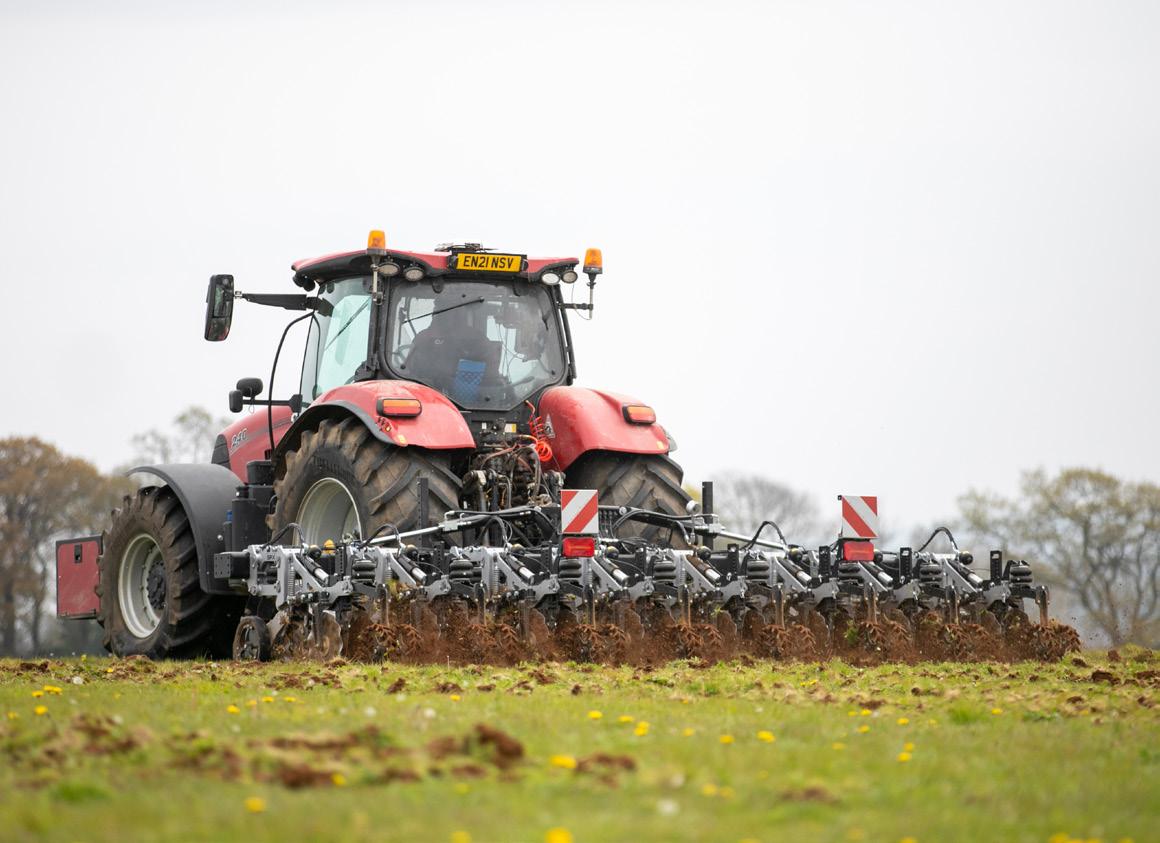
May/ June
The second cut of silage when the grass has regrown takes place in May and June. The dairy cows also stop producing milk and go dry; they have two months off from milking before they calve again getting a well-deserved rest period.
The dairy herd consists of predominantly autumn calving Holstein cows who are grazed and fed a diet without soya or palm oil. We are one of 30 farms in the country whose premium RSPCA assured milk is supplied directly to Marks and Spencer.

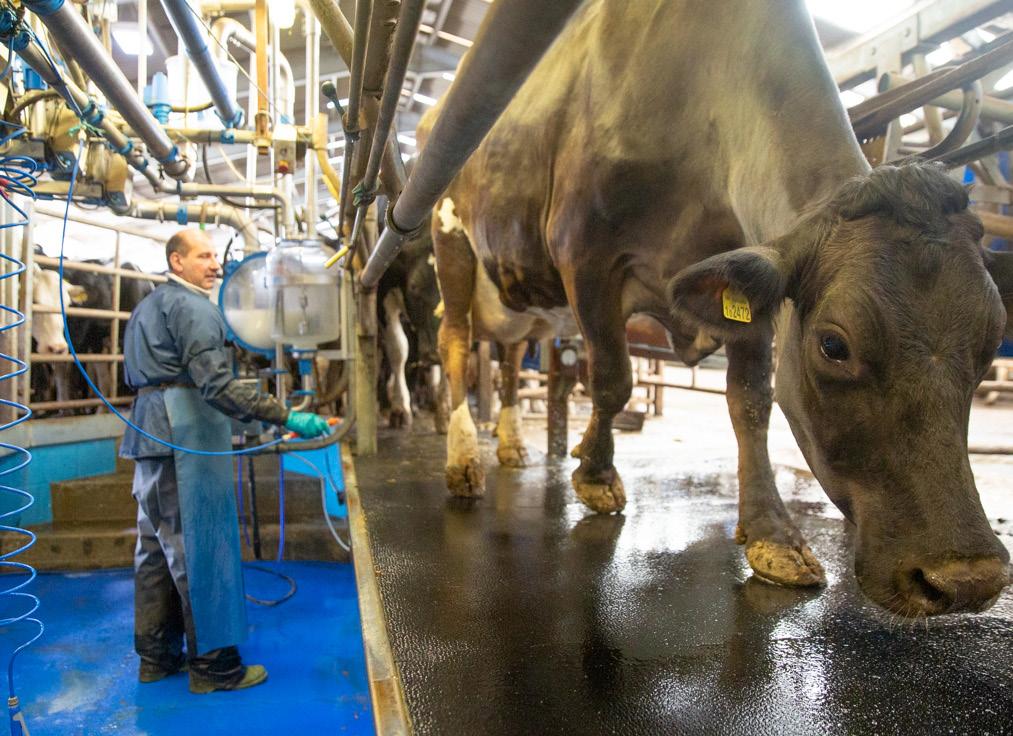

July
At Cowdray Home Farm, we grow wheat, milling rye, malting barley, oilseed rape, Lucerne grass and maize.
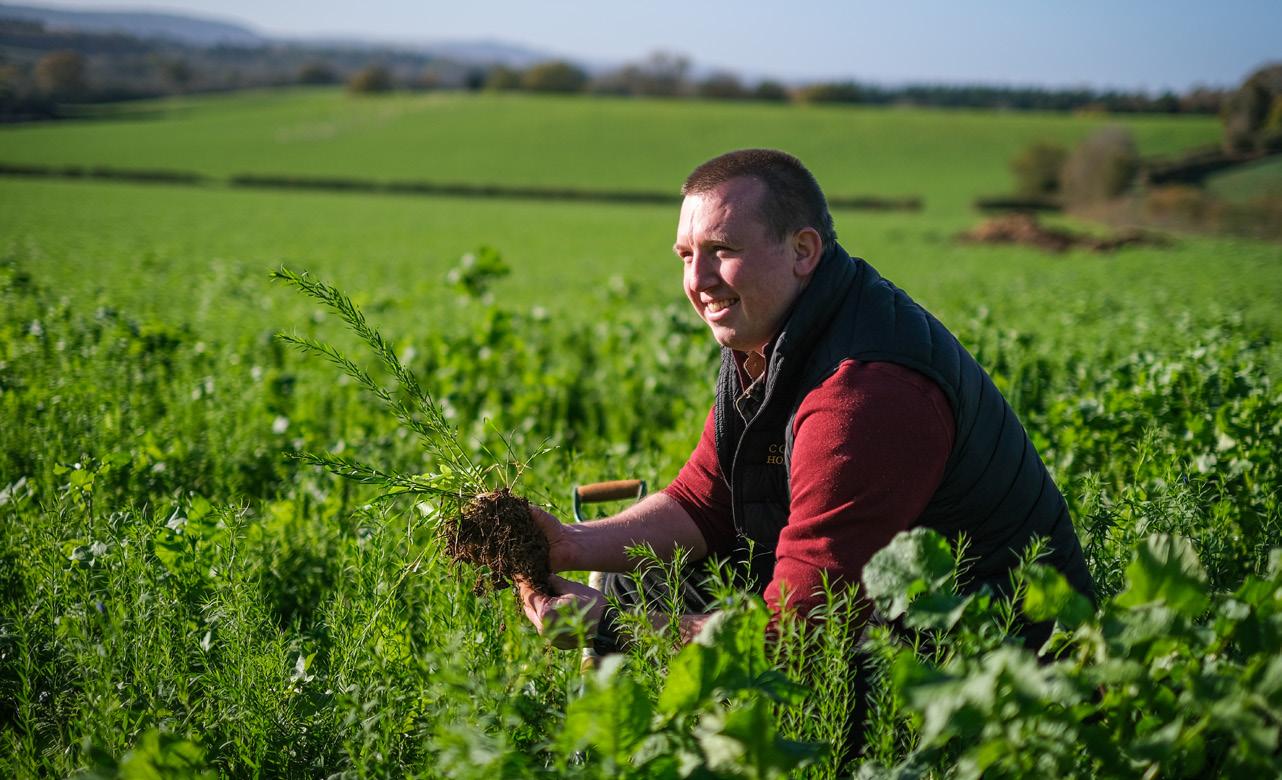
We have also been growing some novel crops such as stubble turnips for the cattle feed, and malt and barley for Langham Brewery as well as oil seed rape for cooking oil. We start harvesting early crops such as winter barley.
The cows start calving in July.
August
This is a very busy month. Fingers crossed for good weather, and then its go, go, go! Last year’s long dry spell presented a real challenge as the yield was down and the grain was too dry.
We harvest wheat, oats and rye and barley through this period. We put the crop through our combine harvester which cuts, threshes and cleans the crop on the move before depositing it into trailers to take back to the farm for storage. This is then sold throughout the year when we feel the price is best. Harvest is very weather dependant, and we work a lot of hours over this period to ensure all the years’ hard work is not wasted.
As soon as we have harvested a crop, we try to grow a sacrificial crop which holds the soil together. By keeping living roots in the soil all the time it helps with the soil’s biology. We also drill catch and cover crops.
Pictured clockwise from top left: Morning milking at Moor Farm, the strip-till cultivator in action, a newly born calf, Barney inspecting the cover crops
September
The busiest time of the year is coming to an end. The last month of the harvest focuses on beans and spring crops. We start crop drilling for rye, wheat and winter barley and we also carry out the third cut for grass sileage. We produce 3,500 tons of grass silage and 3,000 tons of maize.
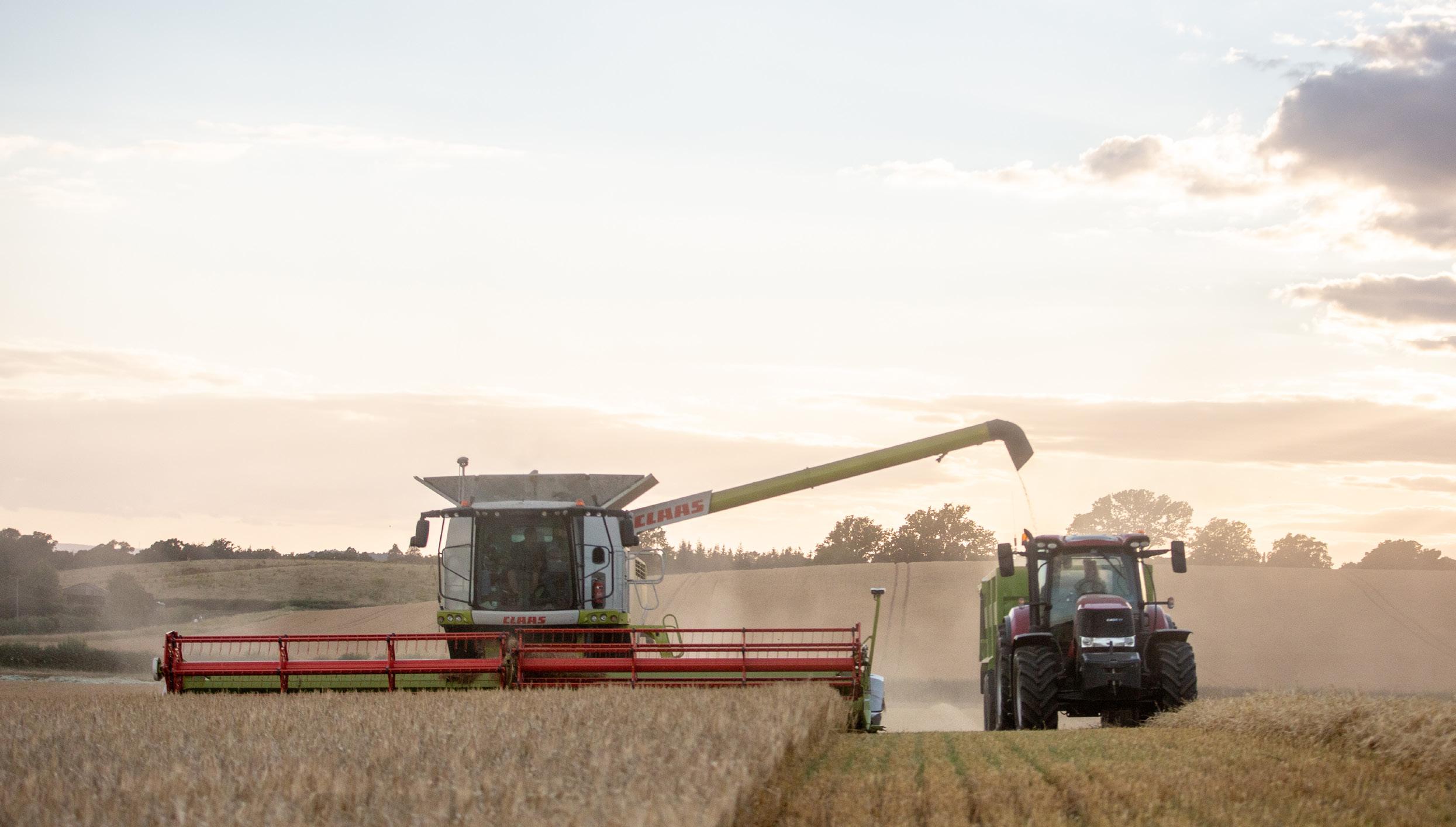
October
Now that the harvest is over, we finish all the drilling, ditch and drainage work. We also complete the coppicing work and combine all the maize into grain. We actively try to reduce herbicide use by mechanically weeding crops and use drone technology to monitor the fields and to plot weed numbers and crop growth.
November
The cows get served, getting them in calf again, for which they have a nine-month gestation period. The winter cattle are out on the land and the sheep are grazing on the cover crops.
December
Winter jobs like milking take place. When the cows get to the end of their lives as dairy cattle, they transition into mature beef for the Farm Shop. We prolong their life so they can feel the sun on their backs, and effectively fatten them up on the crops. This enables the dairy cows to have a good quality of life at the end, and ultimately produces some very flavoursome beef which is sold on our butchery counter.
Barney works with a team of five: three members of staff who work full time on the dairy, and two general farm workers. Additional people are brought in to help with the harvest.
Glossary of terms
A catch crop is a fast-growing crop that is grown between successive plantings of a main crop for six weeks or longer.
Cover crops are plants that are planted to cover the soil over winter rather than for the purpose of being harvested.
Crop residues are the remains of the crop after the valuable part has been harvested. They provide a very important cover for the soil.
Direct drilling is a system of planting without cultivation, the soil is left largely undisturbed with crop residues on the surface.
Silage is a method of preserving forage for winter feed, it is compacted and stored in airtight conditions where it naturally pickles to preserve it.
Strip-till is a conservation system that minimises cultivation to just the seeding zone of the crop, this can reduce soil movement by 80 per cent.
Focusing on Polo
Official Cowdray Park Polo Photographer Mark Beaumont talks about why he is passionate about his work and describes the thrill of capturing a good image both on and off the polo pitch especially during the much-anticipated Cowdray Gold Cup.

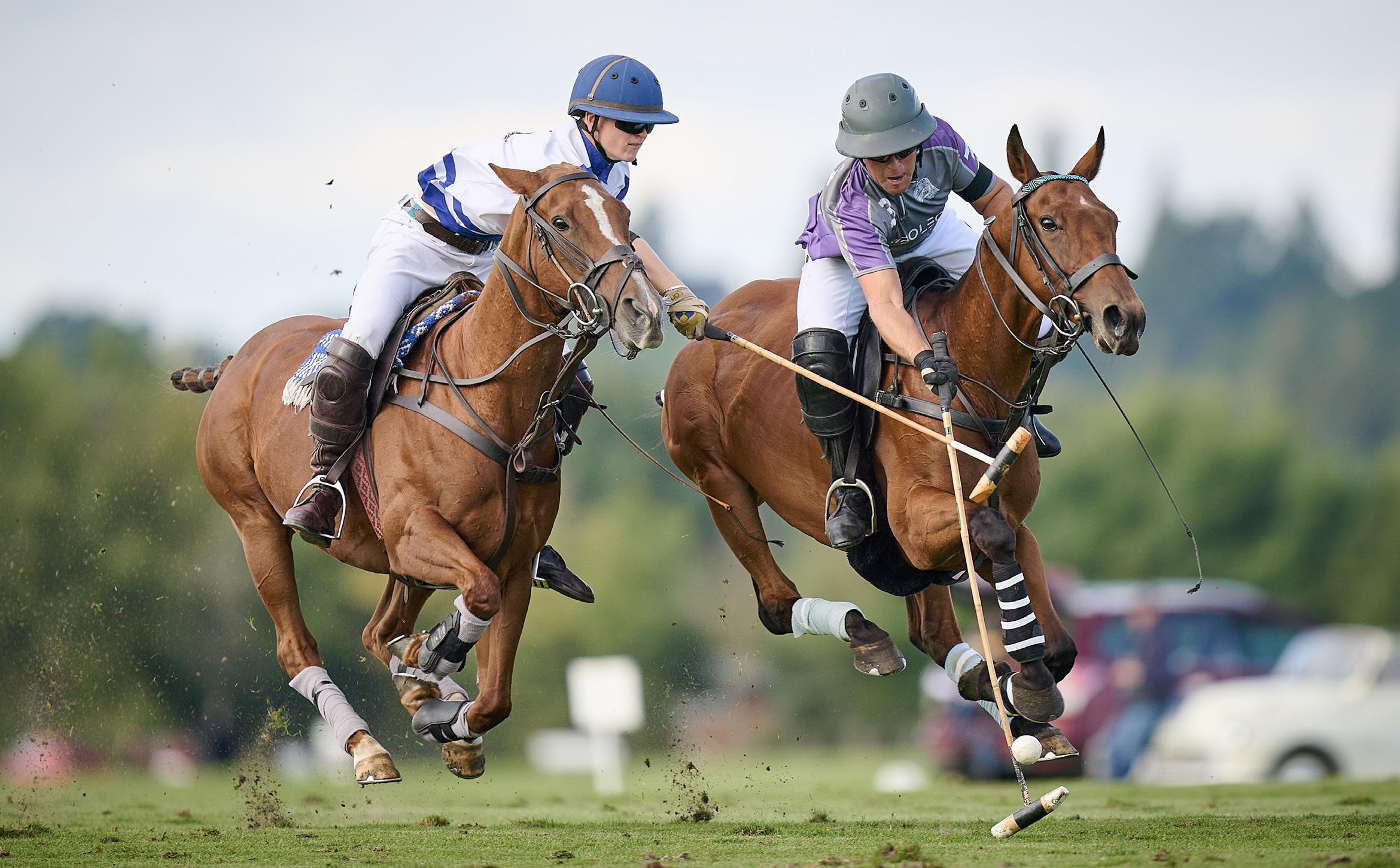
From the moment I started photographing polo 12 years ago, I was hooked. I began at a local club level, but soon after starting I was asked if I wanted to be the club photographer for Ham Polo Club. After only a year there I was asked to shoot exclusively for the King Power Polo teams, which I did for the next four years. Shortly after the 2018 season had finished, I received a call from Cowdray Park Polo Club asking if I wanted to come in for a chat about their photography. Since the day I photographed a game on the Lawns in 2013, I knew that this is where I wanted to be.
So, what’s it like to be the official club photographer covering everything from the two goal tournaments to the prestigious British Open Polo Championship for the Cowdray Gold Cup? Whilst the club hosts over 500 games each season, the highlight of the season is undeniably the Gold Cup, which is held over three weeks from the end of June. It’s a very busy time for me photographing as many of the league matches as possible, and most importantly, all the 10 trophy games which take place throughout the tournament, culminating in the muchanticipated final. It’s not just about capturing the fast-paced polo action, there’s plenty more going on around the ground too. The pony lines are my favourite haunt especially if I can get there earlier enough to photograph the ponies before the start of the game.
Sponsorship is also a very important part of polo and it’s no different at Cowdray. It’s important that I get shots with the sponsors banners or flags and any other brand identities that can help give extra value to a sponsor’s package. I work very closely with the team in the polo office, making sure I provide them with enough images. Many of these images will only see the light of day when the club is putting together the sponsor packages for the following season.
All hooves off the ground in the subsidiary Final of the Farewell Cup
Friends in the pony lines
Throughout the finals and semi-finals day, I try to cover as much of the spectator areas as possible and any of the entertainments going on too: I am constantly on the move. As you can imagine with the size of polo field, I end up covering quite a distance. Last year’s semi-final day, I walked nearly 14 miles! Strangely the final day is not as hectic for me as the semi-finals, which has two big games compared to one.
Once the polo has finished and the immediate celebrations are over, I quickly head back to my desk and start editing. I can normally turn around a day’s work in the same day, albeit often late into the evening. On final days, this tends to be in the early hours of the following morning. My goal is to have the edited files ready for the club to use first thing the following day and this goes for all the other matches throughout the season too, not just the Gold Cup. Occasionally we need images sooner, so with a laptop and good 4G signal, (we’re very lucky to have that at Cowdray) I can have an edited file ready for distribution within a few minutes of the shot being taken.

I’m fortunate enough to have spent many years photographing horses, from mini Shetlands to mighty Shires and this has set me in good stead for polo photography. However, there’s something very special about the game of polo for a photographer. At times you’re quite spoilt for choice with so many opportunities presented to you, though I guess the secret and skill is knowing where and when will the opportunities arise. There’s no doubt in my mind that the light at Cowdray is quite special, especially on Brooks at Ambersham Polo Grounds. When I’m not shooting for Cowdray I also work for other large venues covering events as well as working for private clients.
I’m not sure I know what makes a good polo photographer but a certain degree of technical photographic skill, and an understanding of how light affects a scene helps. I do believe a good eye for composition is essential and not necessarily something that can be taught.


 www.markbeaumont.co.uk @markbeaumont_photographer
www.markbeaumont.co.uk @markbeaumont_photographer
“...there’s something very special about the game of polo for a photographer. At times you’re quite spoilt for choice with so many opportunities presented to you...”
Action on Lawns for the semi-final of the British Open Polo Championship for the Cowdray Gold Cup
Luxury Treehouse Escapes
Four new luxury Treehouses are the latest addition to Cowdray’s holiday portfolio providing guests with a calm and beautiful place from which to explore the Estate and the local area.

Four new Treehouses tucked away in an ancient beech woodland behind Lawns polo fields offer visitors a chance to relax, unwind and reconnect with nature while enjoying a luxurious stay. Known as Buzzard, Chukka, Griffin and Muntjac, the well-equipped and beautifully designed treehouses, which each sleep two adults, are named after either wildlife in the local woodland or things you can spot from the balcony.
They are integrated with the woodland with wrap around balconies featuring an outdoor bathtub on the terrace, glass doors and large windows. Guests arrive at the Treehouses in electric buggies which can then be used to transport them around specified areas of the Estate.
Built using sustainably sourced timber from the Estate, the Treehouses are the result of a collaboration between Cowdray and Tree House Retreats, who have designed, built and now operate them as holiday lets.
They are the most recent exciting new addition to Cowdray’s extensive holiday portfolio, with nearby Costers Lodge being the latest refurbished holiday cottage to be available for short term lets. Challens Yarde in Easebourne and Apsley Cottage in Bepton have also been newly renovated and are available alongside the popular four holiday cottages at Benbow Pond. There is also bed and breakfast accommodation at the Lodge overlooking the Lawns Polo Field complete with a quirky bothy.
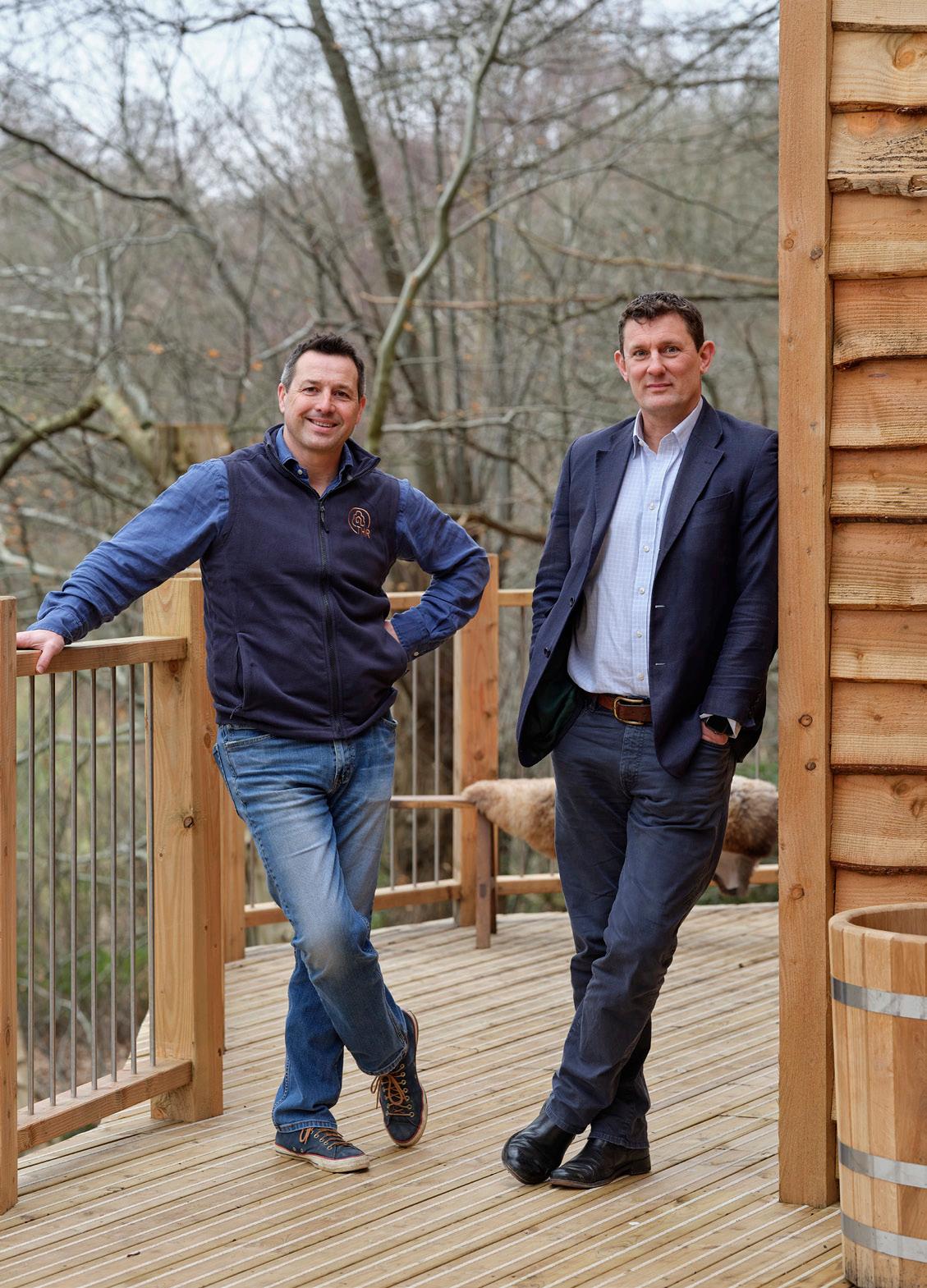 Adam Coxen, Founder of Tree House Retreats (left) and Jonathan Russell, Cowdray’s CEO (right)
Adam Coxen, Founder of Tree House Retreats (left) and Jonathan Russell, Cowdray’s CEO (right)
Jonathan Russell, Cowdray’s CEO, and Adam Coxen, Founder of Tree House Retreats along with his partner Mike Ruddock, have worked together over the past four years on the project to turn it from a vision into a reality.

Jonathan Russell said: “At Cowdray there is a desire to innovate and to embrace new yet environmentally friendly projects which allow as many people as possible to enjoy the Estate and the stunning surrounding area. That is why I have been so passionate about the Treehouse project and about expanding our holiday portfolio.
“The Treehouses are beautiful, natural, sustainable buildings built sensitively within Cowdray’s woodland. They offer guests the best possible experience, which is also respectful of the natural environment. The values and vision for the future of
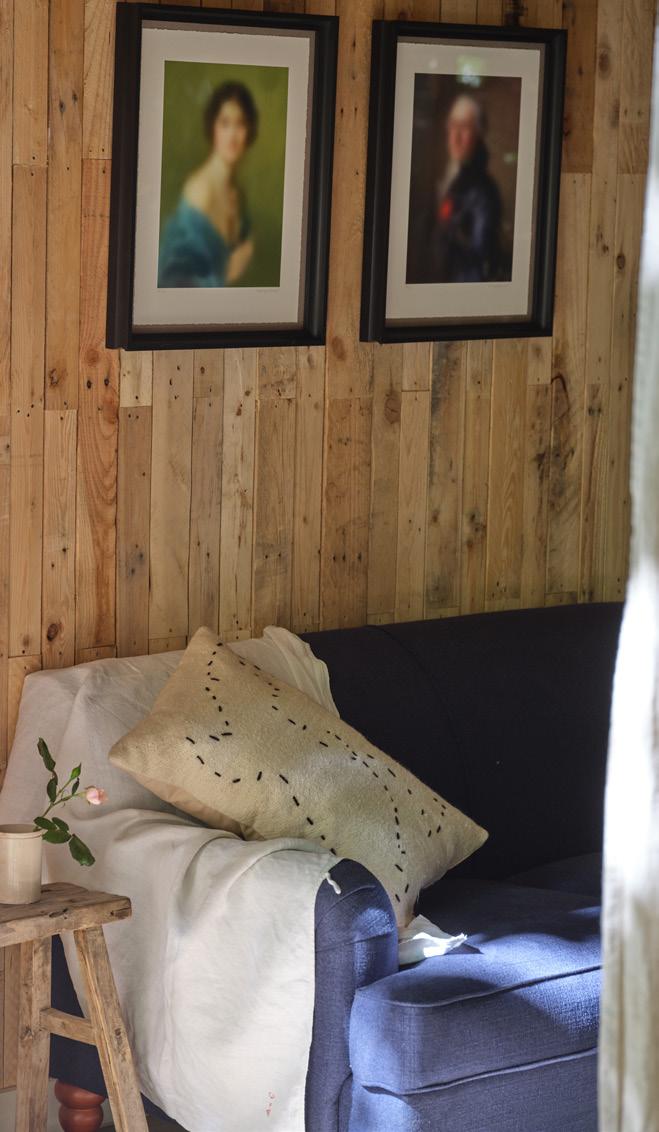
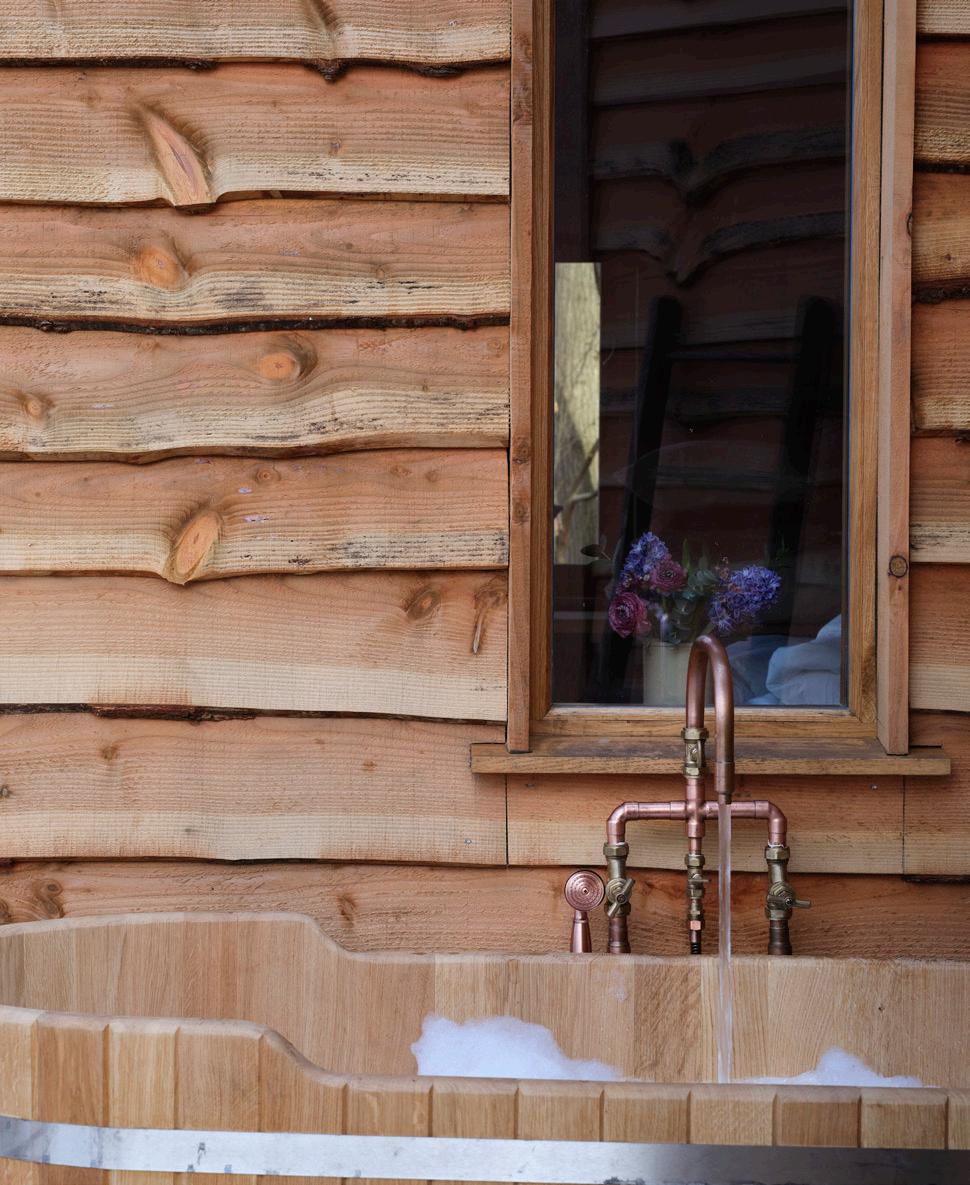
Tree House Retreats aligns strongly with Cowdray’s, and it is fantastic to see this project come to fruition.”
The project started four years ago and involved two years in planning with a collaboration between Tree House Retreats, Cowdray Estate and the South Downs National Park Authority. Being built in an ancient beech wood meant that there have been several planning conditions to take into consideration as well as the need to sensitively manage the project to ensure the local landscape and the woods are protected.
Once all the planning requirements were met, the Treehouses took a year to be built. The Cowdray forestry team were instrumental in enhancing the five-acre woodland site including removing rhododendrons, which are non-indigenous invasive plants and helping to manage and prepare the woodlands.
“The Treehouses are an incredibly special place to visit whatever the time of year and I love spotting the wildlife from the balcony as well as just absorbing the view.”
Adam Coxen - Founder, Tree House Retreats
Adam Coxen, from Tree House Retreats, said: “It has been a long journey to get here but it is fantastic to now step back and look at the Treehouses through the eyes of a guest, and we feel really blown away by the project.

“Cowdray and Tree House Retreats have a shared attention to detail, and a desire to create the best and most sustainable possible experience for visitors. The Treehouses are an incredibly special place to visit whatever the time of year and I love spotting the wildlife from the balcony as well as just absorbing the view.”
Inside there are super king-sized beds, spacious open plan living rooms and kitchens, and a bathroom with walk-in shower. The Treehouses also have carefully thought-out details such as yoga mats, picnic rugs, board games and books for use during guests’ stay.
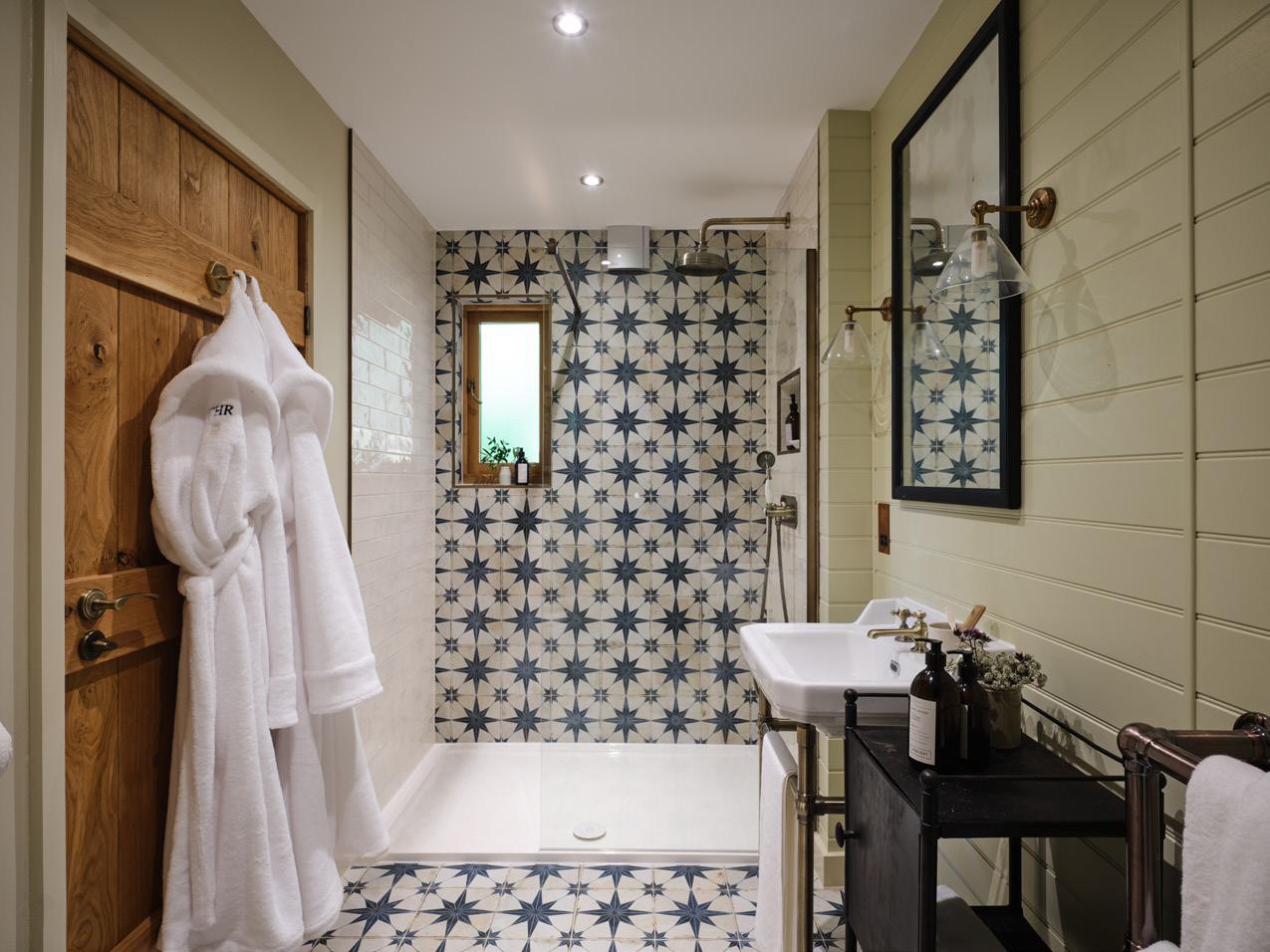

The Treehouses were developed using a ‘fabric first’ approach and are highly insulated to reduce energy consumption, use Structural Insulated Panels and air-sourced heat pumps along with other measures to ensure their sustainability.
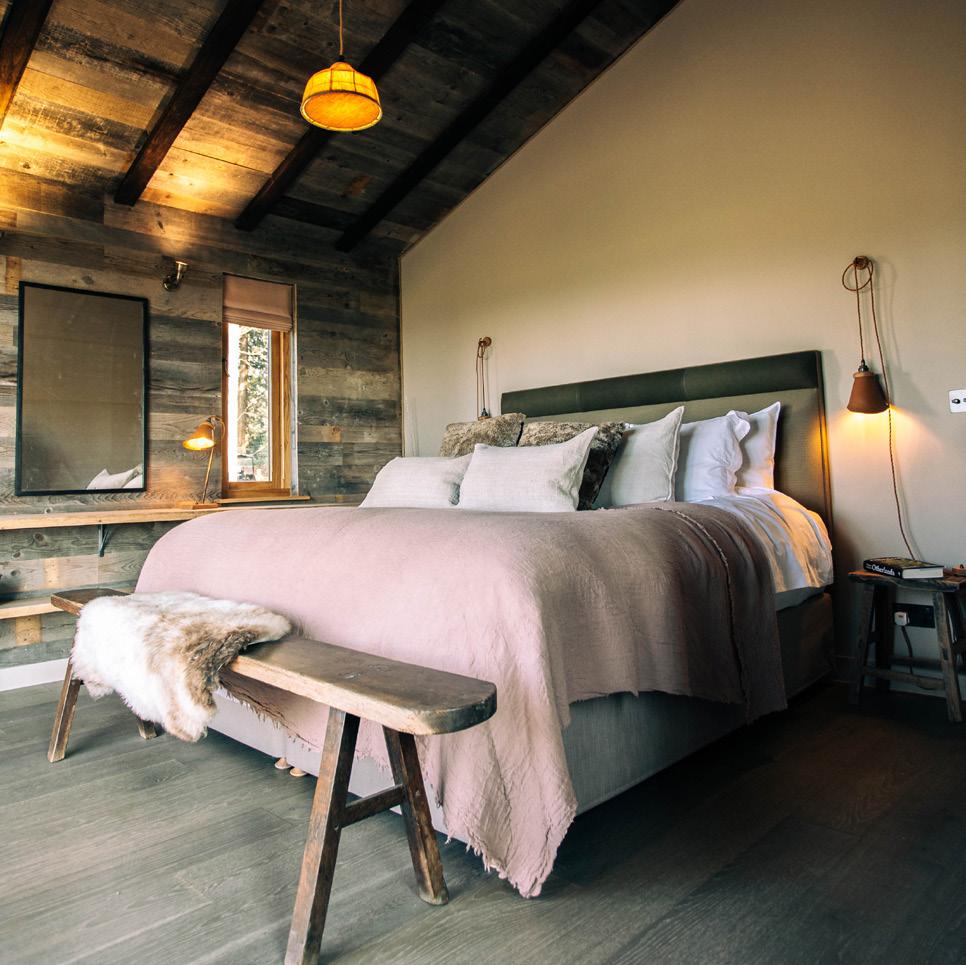
“The Treehouses are beautiful, natural, sustainable buildings built sensitively within Cowdray’s woodland. They offer guests the best possible experience, which is also respectful of the natural environment.”
Jonathan Russell - CEO, Cowdray
A lot of thought has gone into the interior design with Lou Davies of Box 9 Studios taking charge of the interiors. Vintage and antique furniture sits alongside locally sourced materials, all chosen with sustainability, provenance and durability in mind. The interior design celebrates natural beauty with vintage linens, sheepskins, woollen blankets and antique rugs in earthy forest tones.
Modern art has been sourced in conjunction with Migrate Art, who collaborate with international celebrated artists to raise money for displaced and homeless communities.
Each guest receives a welcome hamper from the Cowdray Farm Shop stocked with locally produced food and drink such as honey from hives on the Estate, seasonal fruit and vegetables and baked goods made onsite.
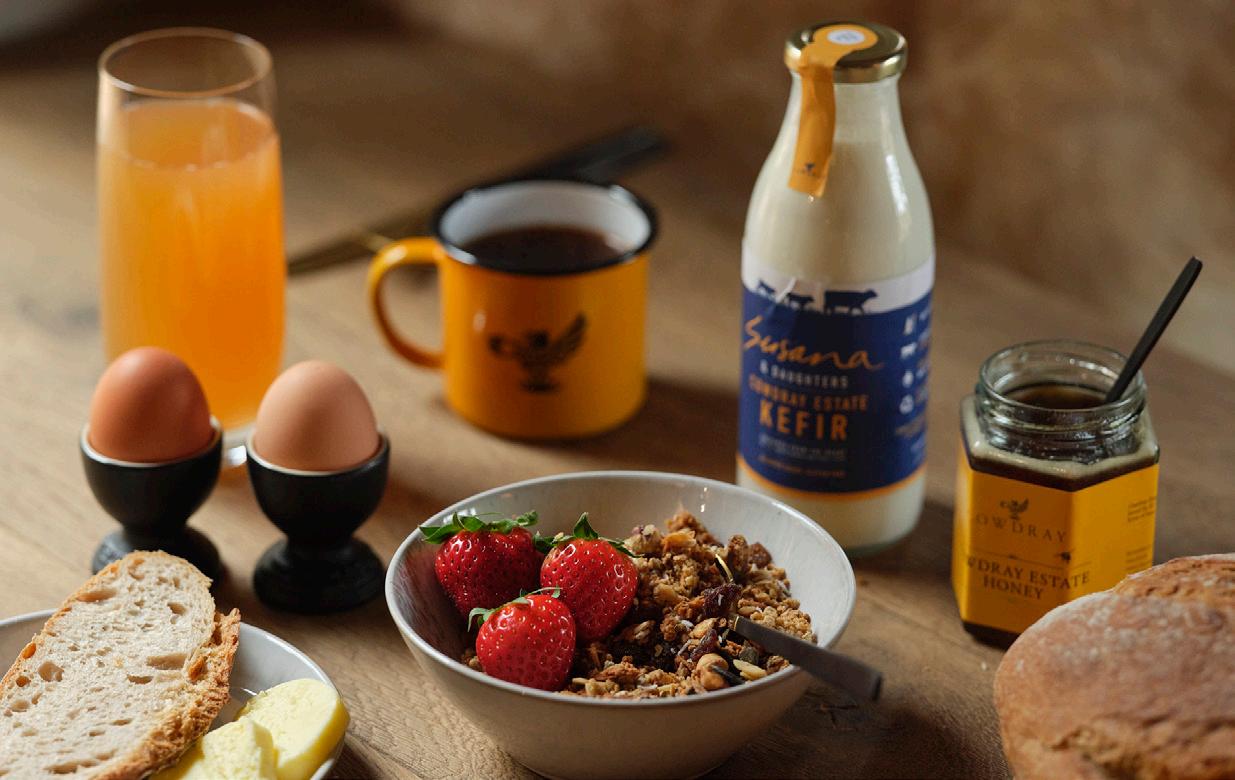
Guests also have access to everything that the Estate has to offer. The Farm Shop & Café is an easily stroll away, and Cowdray’s 18-hole championship golf course is nearby. As well as classic country pursuits such as polo, golf and shooting there are also wellness retreats, art classes, foraging walks through the grounds and star gazing. Cowdray is situated within the South Downs which became the newest International Dark Skies Reserve in 2016.
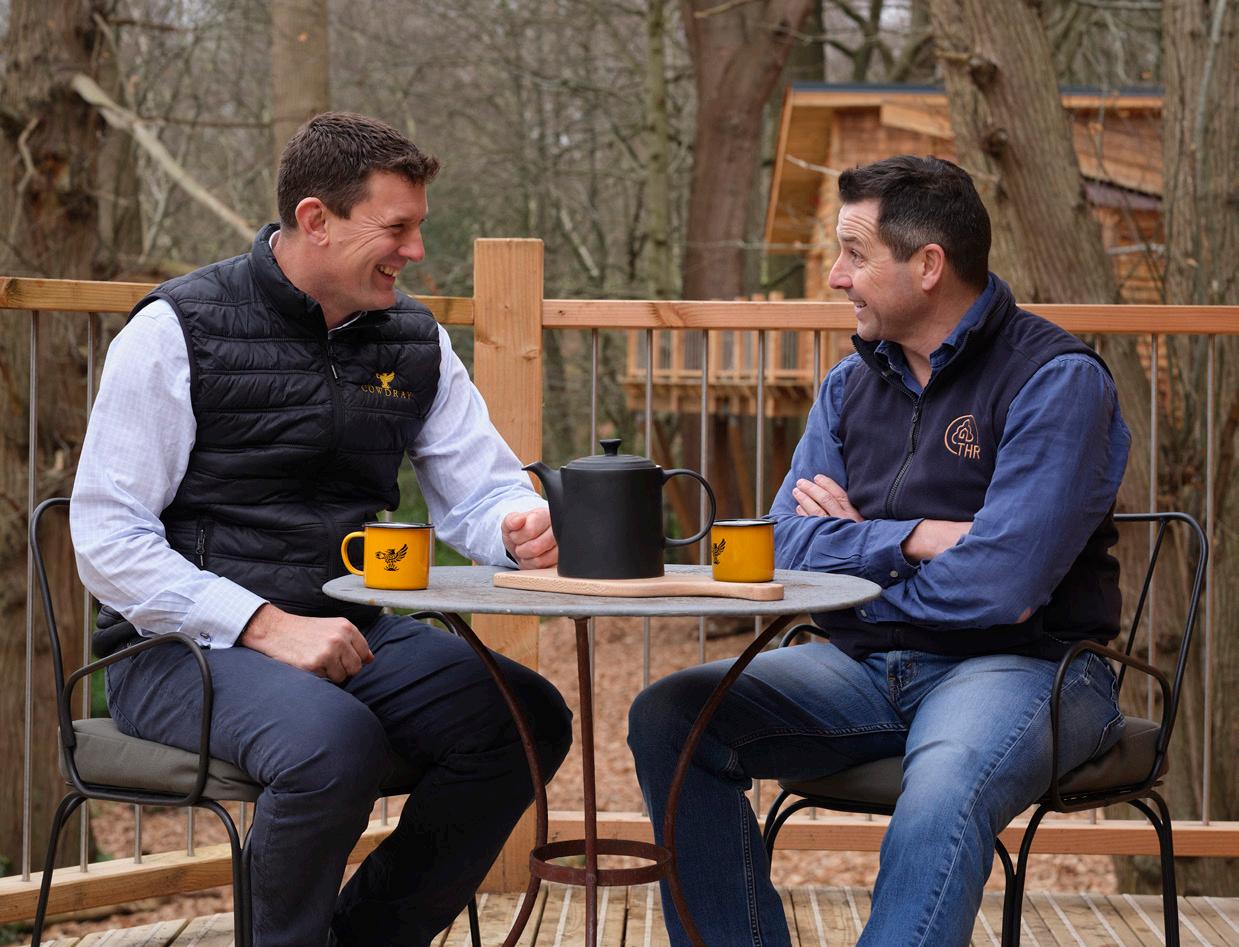
To find out more about the Treehouses and other accommodation on the Estate, please visit: www.treehouseretreats.com/book or www.cowdray.co.uk/stay
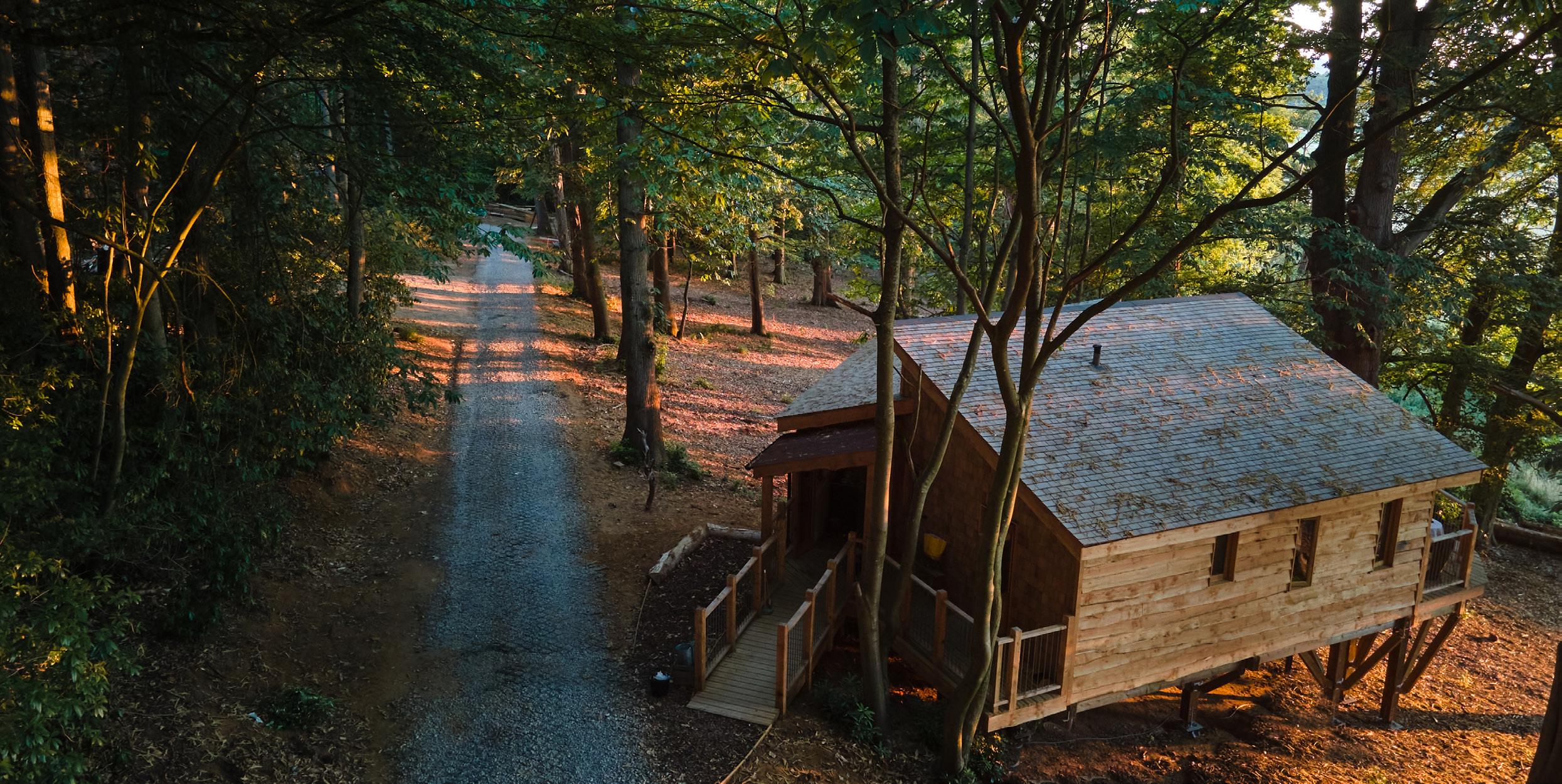
Cowdray Farm Shop and Café
What’s on at the Welcome:
At the Cowdray Farm Shop & Café, we pride ourselves on being customer led. We do our best to ensure that the shelves are filled with an array of the best quality artisan food and drink, however if you can’t find what you are looking for, talk to the team and we will try and source it. The same level of bespoke service also applies in the Café. Our chefs will make every effort to adapt dishes according to dietary requirements, and to cater for intolerances and allergies.


We believe that customer satisfaction is key, and nothing beats a friendly smile and a face-to-face chat. This ethos particularly applies to the Deli and the butchery, where our team are there to ensure you are buying the best product to suit your needs. The Deli team can help you create the perfect summer cheeseboard or guide you towards cheeses which go well in a summer salad such as mozzarella, halloumi, burrata and blue cheeses.
Customers travel from far and wide for our celebrated meat selection. From BBQ meat to a special côte de boeuf, the team are knowledgeable about how best to cook it and to steer you on what to buy. We are aware that the cost of living has risen and would be delighted to share tips on making the most of your purchase. For instance, a whole chicken can be roasted, then the meat stripped off the bones for Mexican Tacos and the carcass turned into stock. Perfect for our Executive Head Chef Ben Jupp’s risotto recipe on the back page.
There are lots of new initiatives at the Farm Shop & Café including the expanding Cowdray Kitchen range, hugely popular frozen pizzas, new dishes in the Café’s Summer Menu as well as lots of exciting new products in Cowdray Lifestyle. Do pop in and visit us this summer; a warm welcome awaits you.
Rupert Titchmarsh General Manager, Cowdray Farm Shop & Café
Frozen Wood-Fired Pizzas
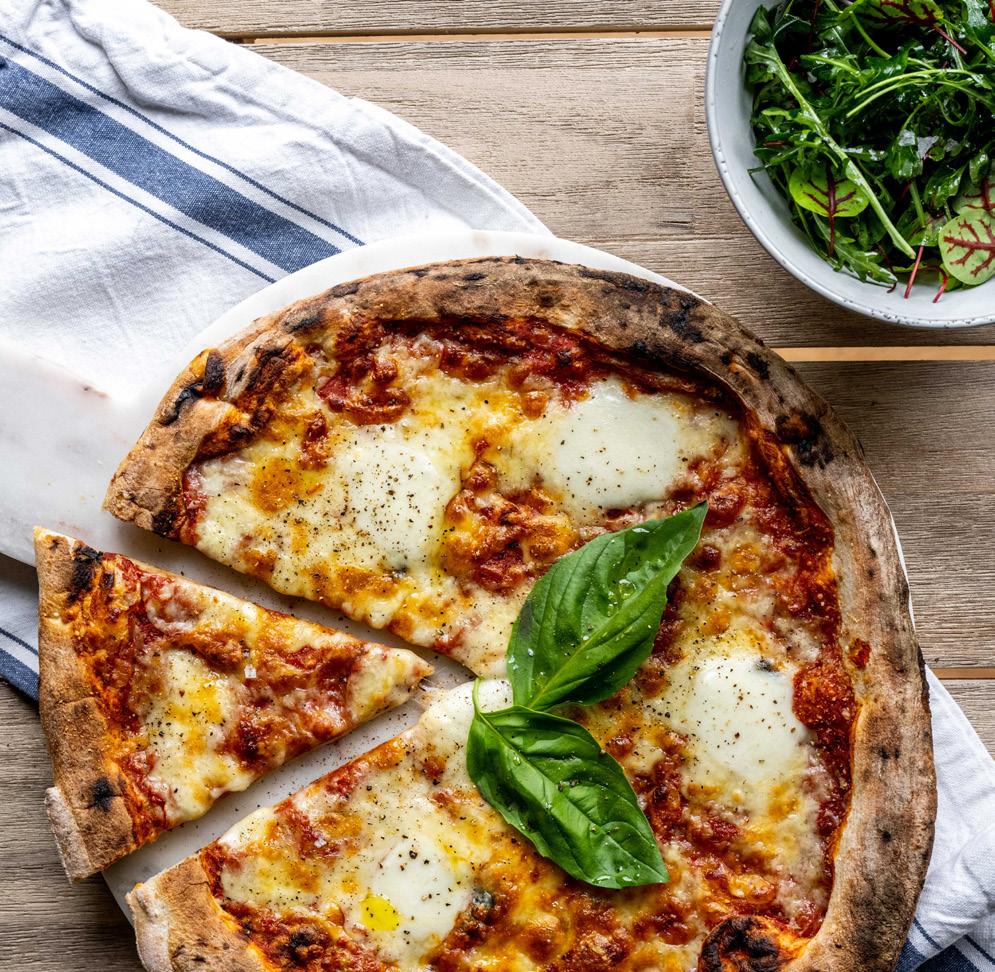
Delicious Cowdray sourdough, wood-fired pizzas are now available from the Farm Shop in the freezer section. Made to traditional Neapolitan and Sicilian recipes, there are three varieties of frozen pizza: ‘Margherita’, ‘Salami’, and ‘Goats Cheese and Caramelised Onion’. There are also garlic bread and plain bases with tomato so you can create your own, perhaps adding mozzarella, anchovies, olives, capers and prosciutto. The pizzas have been part cooked so all you need to do is pop it in the oven at home, and hey presto, its ready!
www.cowdray.co.uk/cowdray-farm-shop
Cowdray Kitchen
What’s for supper? The answer can always be Cowdray Kitchen. There is a wide range of main dishes to choose from including curries, staples such as cottage pie and macaroni cheese as well as vegan dishes such as the Three Bean Chilli. There are also sides including honey roast carrots or braised red cabbage and don’t forget a delicious pudding: tiramisu, crumbles and apple pies to name a few are all cooked and waiting to be enjoyed. All the dishes are bursting with flavour and made using the freshest local ingredients. As well as in the shop, Cowdray Kitchen can also be purchased online and are available for delivery.
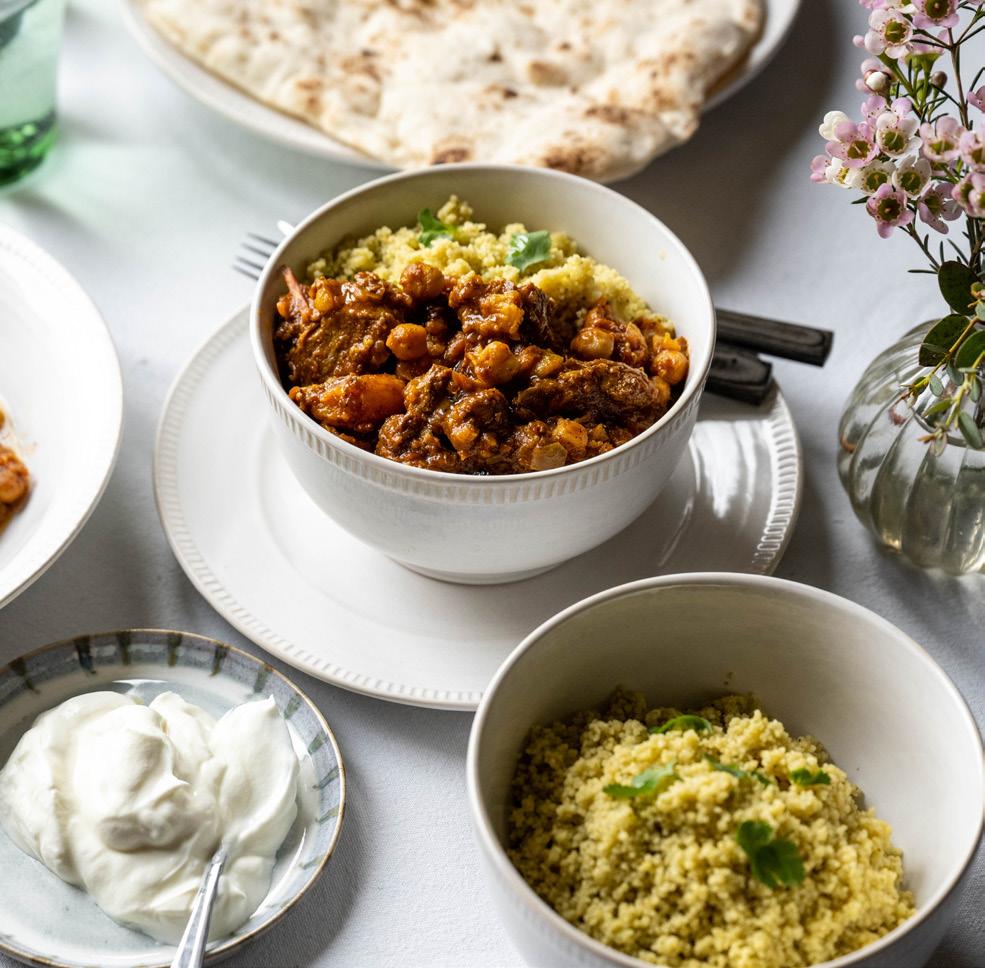
www.cowdray.co.uk/cowdray-shop/cowdray-kitchen-farm-shop
BBQ Range
When the sun shines, there is no better way to eat than a relaxed BBQ with family and friends. Throughout the summer season the butchery is stocked with delicious beef, pork, chicken, wild venison and lamb. Ready-made kebabs, burgers, sausages and koftas cook brilliantly on the BBQ or try a butterflied leg of lamb for the more adventurous.
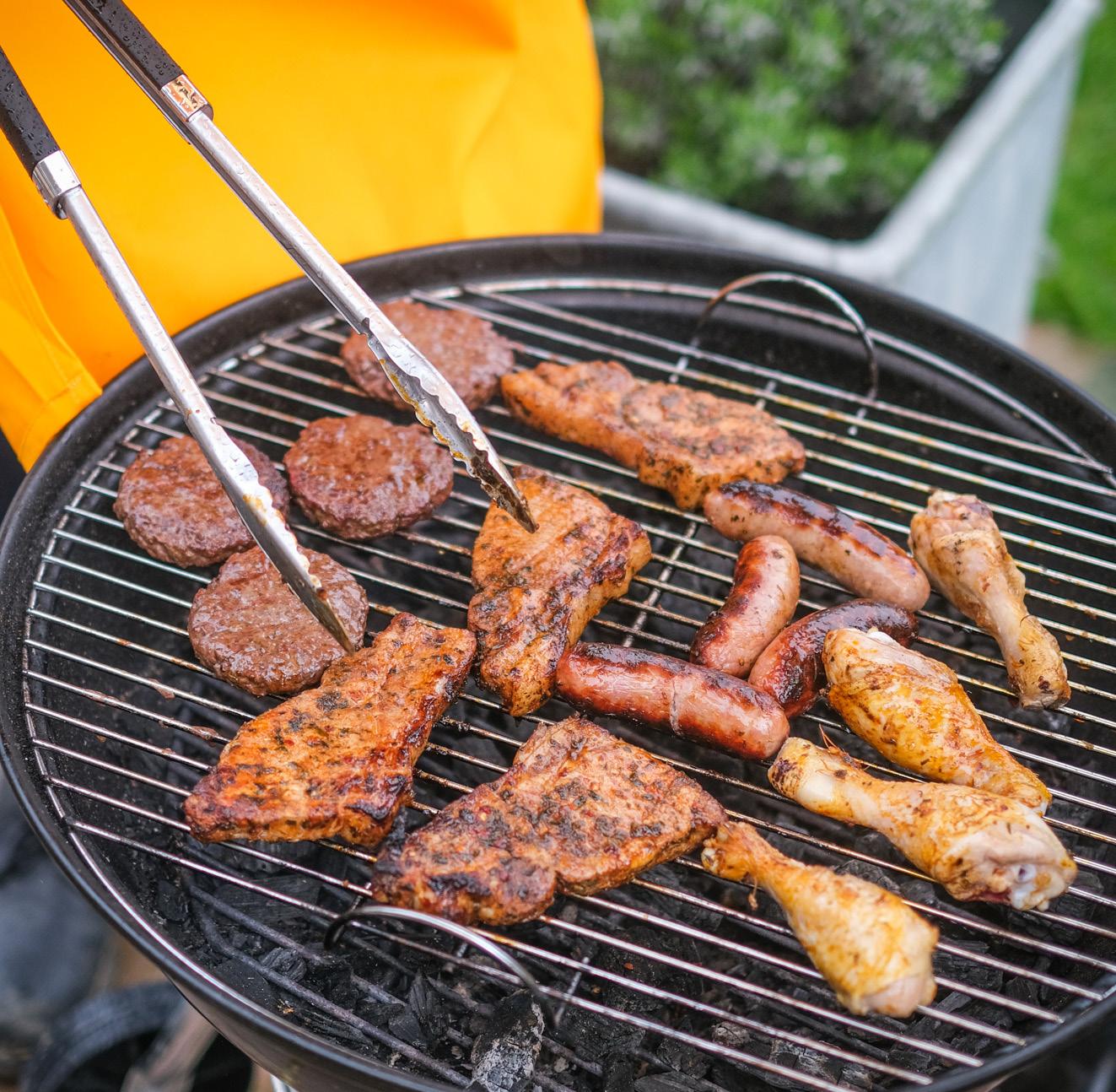
Cowdray Charcoal created on the Estate using sustainable sources of wood is available from the Farm Shop. As are BBQ Boxes are available to grab and go in the Shop, on the website for delivery or to pre-order for collection.
www.cowdray.co.uk/cowdray-shop/butchery
The Café and its Summer Menu
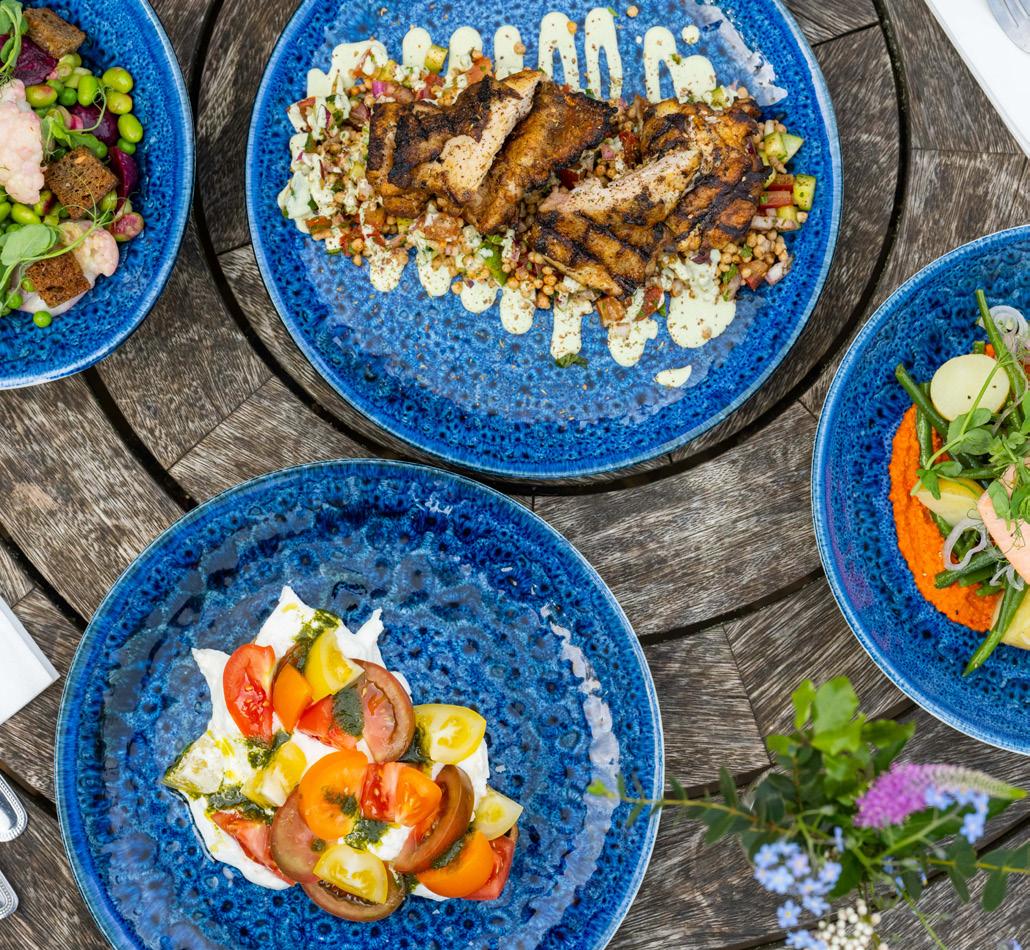
The Cowdray Café is popular all year round but in summer visitors, walkers and polo spectators make the most of the large sunny terrace to enjoy a drink and a bite to eat. There is a range of new dishes on the menu this summer including Cold Poached salmon with Romesco sauce and King Prawns with Sobrasado, butter beans and capers. Firm favourites also remain such as the Cowdray beef burger or the grilled Halloumi burger.
The Café is open seven days a week.
www.cowdray.co.uk/eat-at-cowdray
Picnic Hampers
A Cowdray Picnic Hamper is a stress free and fun way of entertaining. Whether you enjoy it while watching a game of polo, or at a summer event, or just out in the countryside, there is a range of hampers to choose from including The Midhurst, The Sussex and The Easebourne. There are also drink focused hampers and celebration tea hampers. The contents vary but they are all filled with items made by our talented team of chefs or products from some of our most popular suppliers. The Farm Shop requires a minimum of three days’ notice to prepare the order.
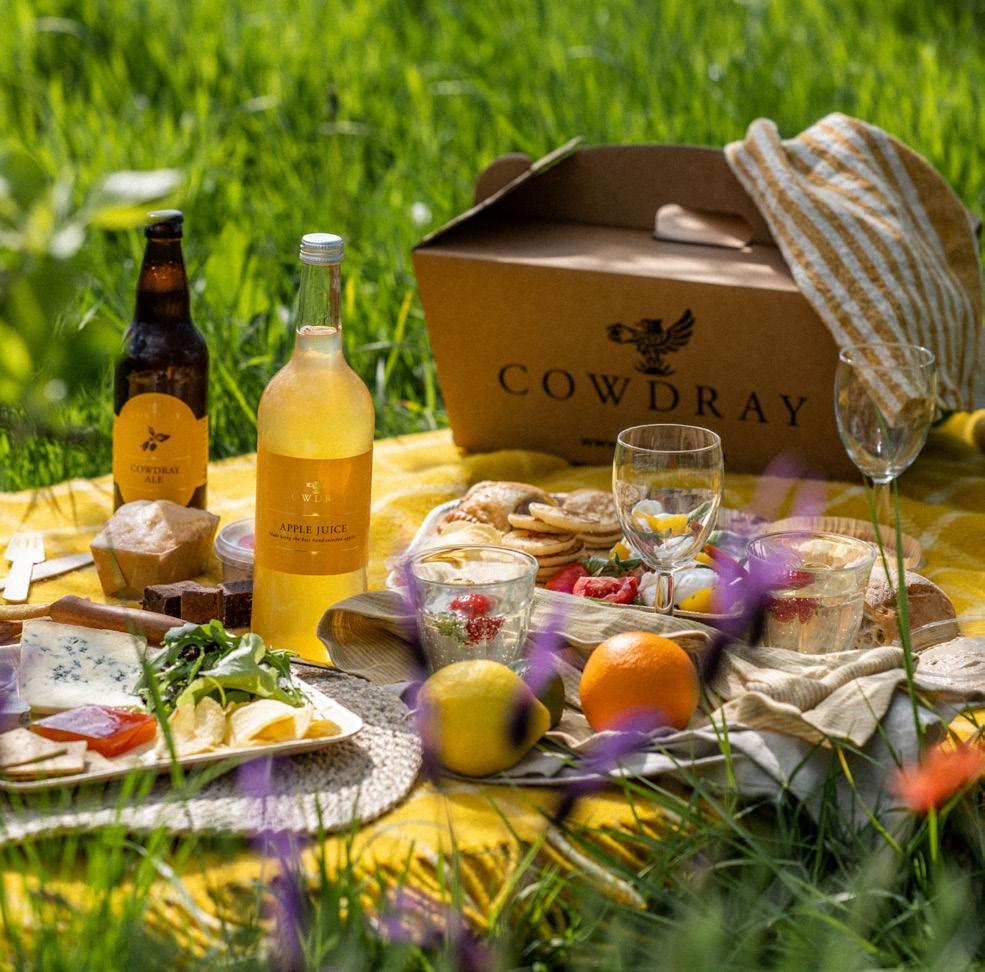
www.cowdray.co.uk/cowdray-shop/picnic-hampers
Fresh Fruit and Vegetables
Particularly during the summer season, the Farm Shop is bursting with vibrant colours and aromas from premium quality, locally grown, seasonal fruits and vegetables. There is a fabulous selection of tomatoes in various shapes and colours from Sussex-based Nutbourne Tomatoes, as well as organic salad from Ed’s Veg and an array of sweet and succulent berries from Munneries. Perfect on their own or as a summer pudding with a dollop of cream.
www.cowdray.co.uk/cowdray-farm-shop
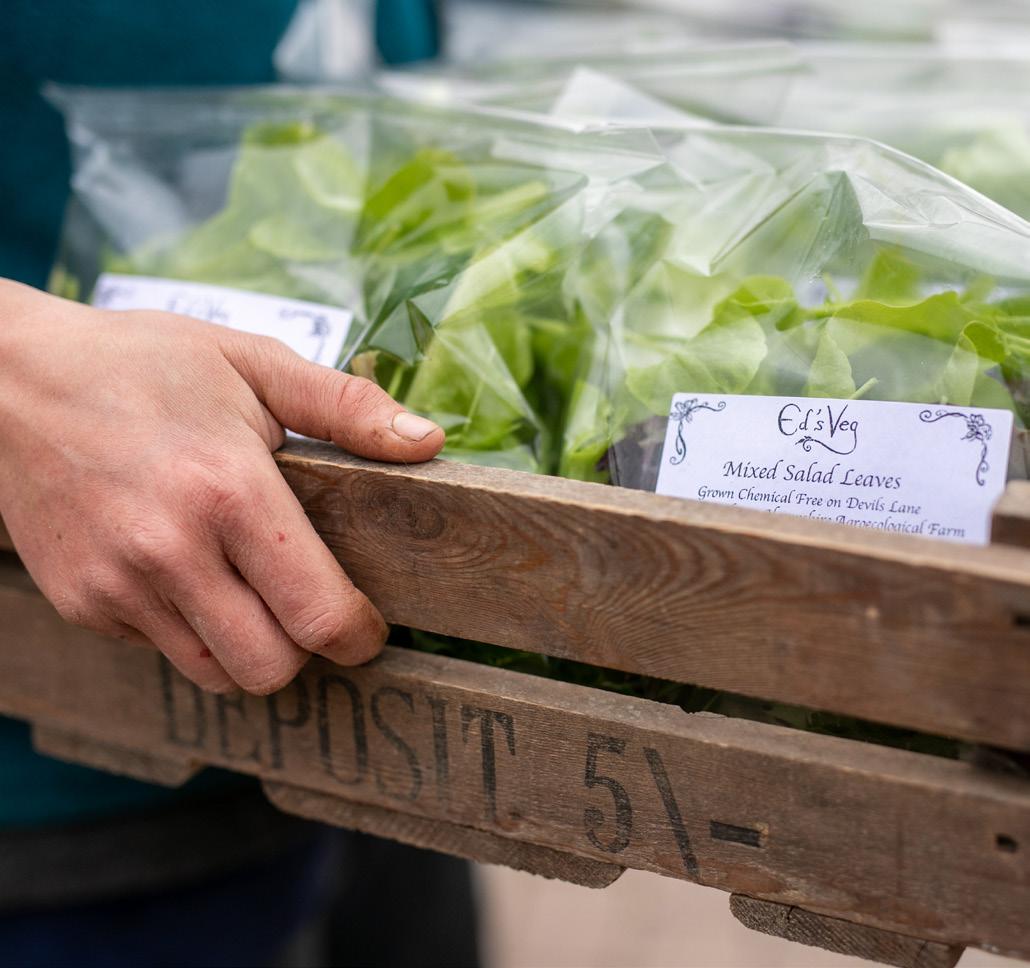
Cowdray Lifestyle
Dinner party presents, thoughtful gifts, children’s books, Cowdray branded items, glassware, picnic blankets, homeware products, cards and stylish wrapping paper: Cowdray Lifestyle is filled with all these and much more. Located opposite the Cowdray Farm Shop & Café, Cowdray Lifestyle’s Retail Manager & Buyer Claire, or one of her team will be on hand to greet you and help with any questions.
Claire picks her five favourite things (pictured above) in Cowdray Lifestyle to give you a snapshot of what’s on offer, but nothing beats having a browse in store. Cowdray Lifestyle is open seven days a week.

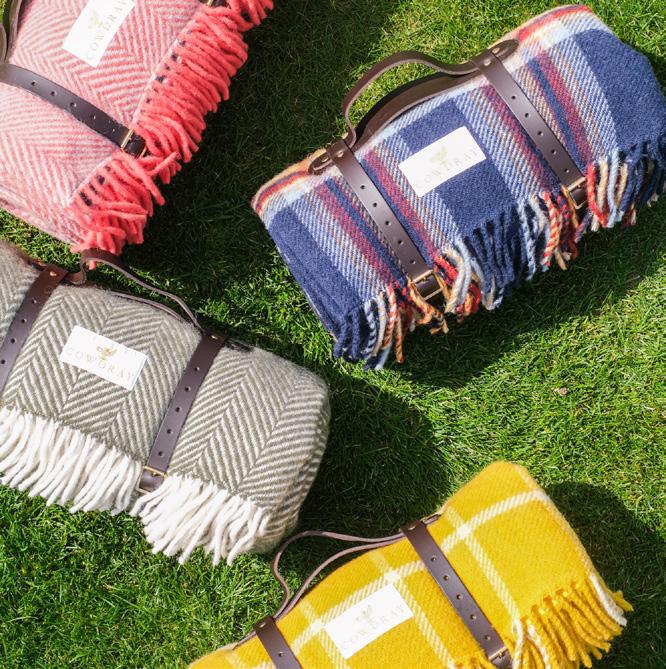
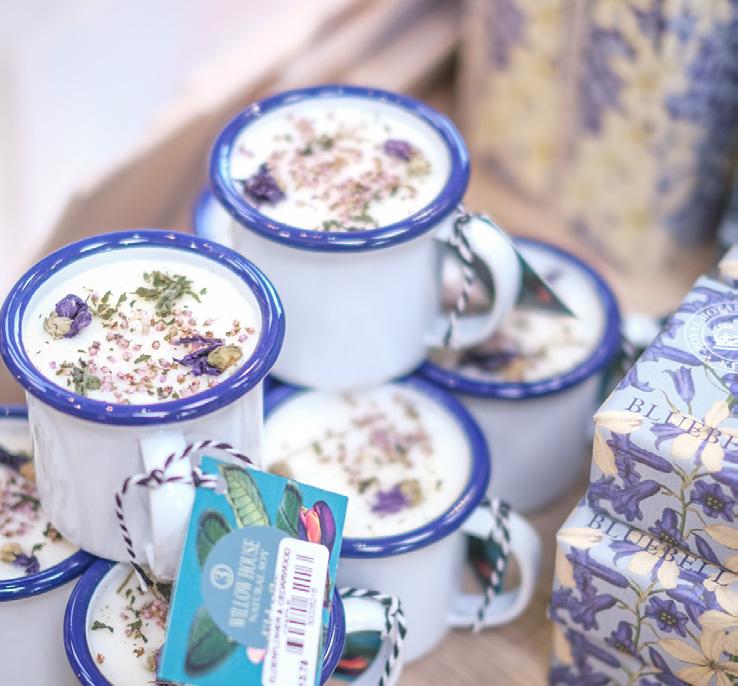
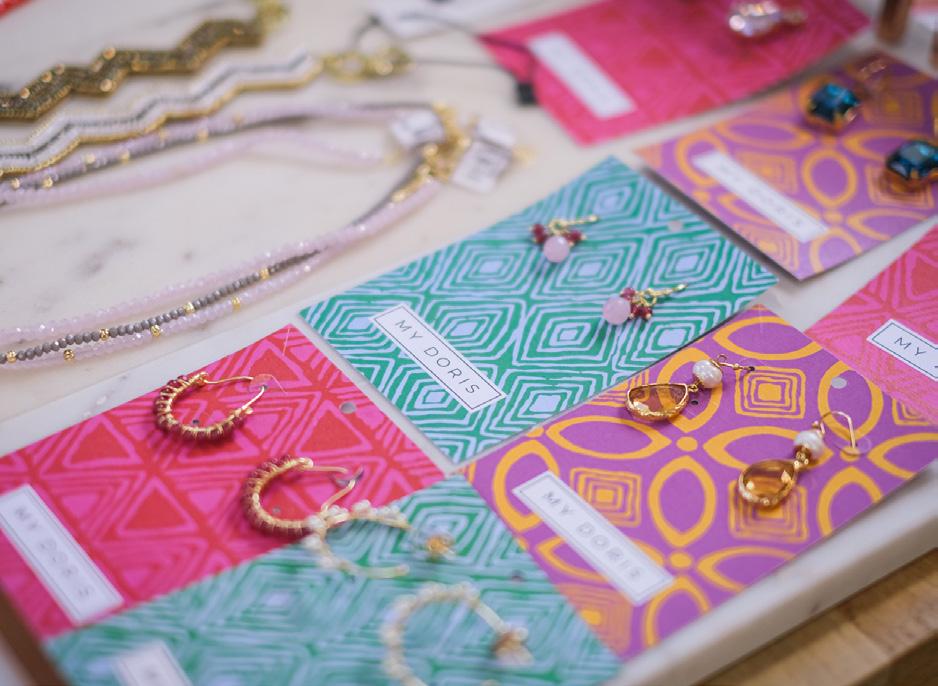

Cowdray Lifestyle Hampers
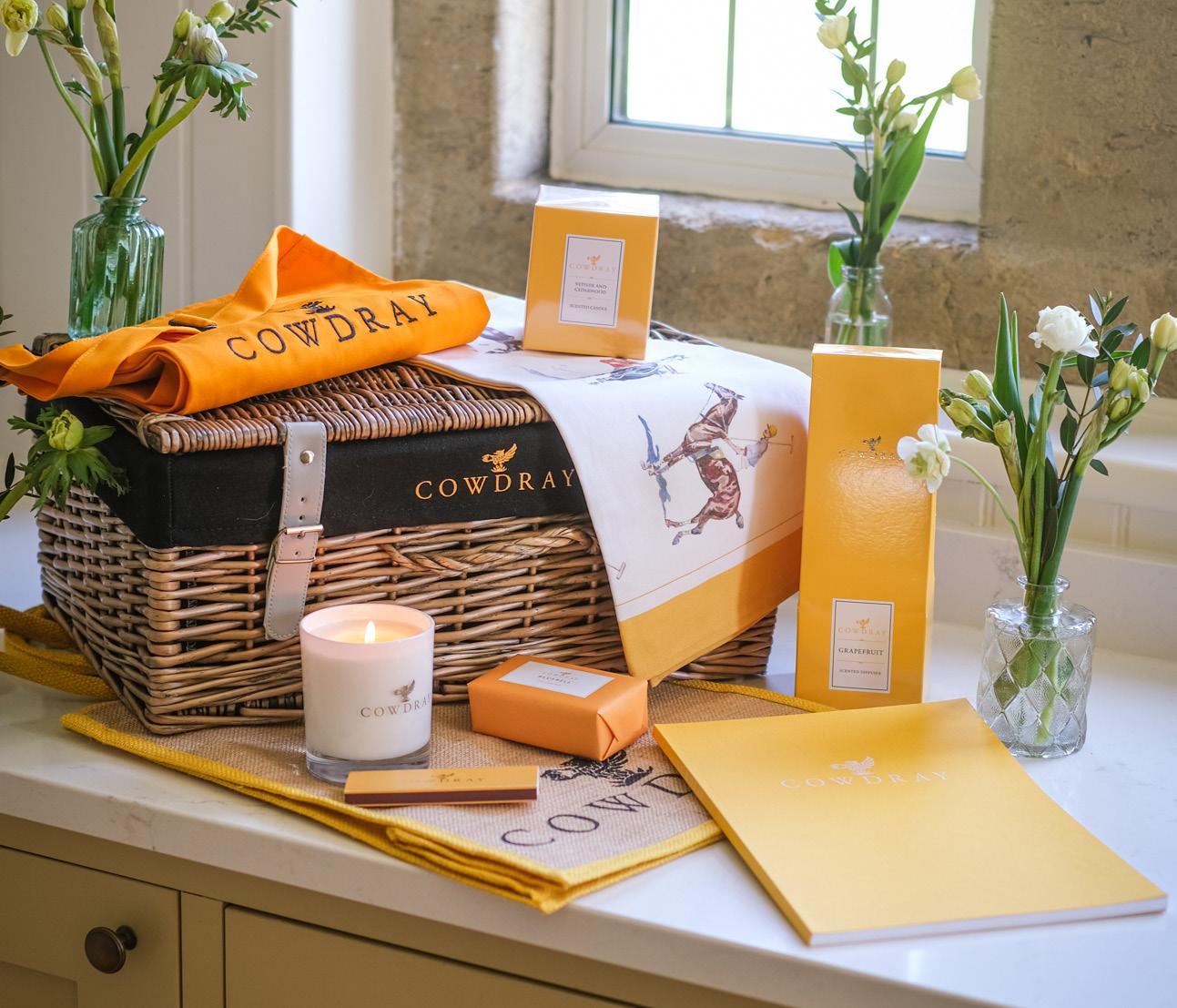
The recently launched Cowdray’s Lifestyle Hampers make the perfect present for family, friends and work colleagues. There are 10 themed hampers to choose from filled with luxury, carefully selected products. These include the Cowdray Collection (pictured left) which contains a unique collection of beautifully designed, fragrant and high quality Cowdray products ideal for the home.
The hampers are available for collection from Cowdray Lifestyle, or they can be ordered online and delivered to your door.
www.cowdray.co.uk/cowdray-shop
Pictured clockwise from top left: My Doris Jewellery, Willow House Soy Candles, Shades of Cool Cowdray Collaboration Kimono Robe, Jellycat Bunnies, Cowdray Picnic Rugs
Cowdray Hall and Therapy Rooms
Meet the Therapists
A wide range of therapists practice out of Cowdray’s Therapy Rooms. Matilda Reid talked to four therapists about about what inspired them to train in their profession and the benefits of each individual therapy.
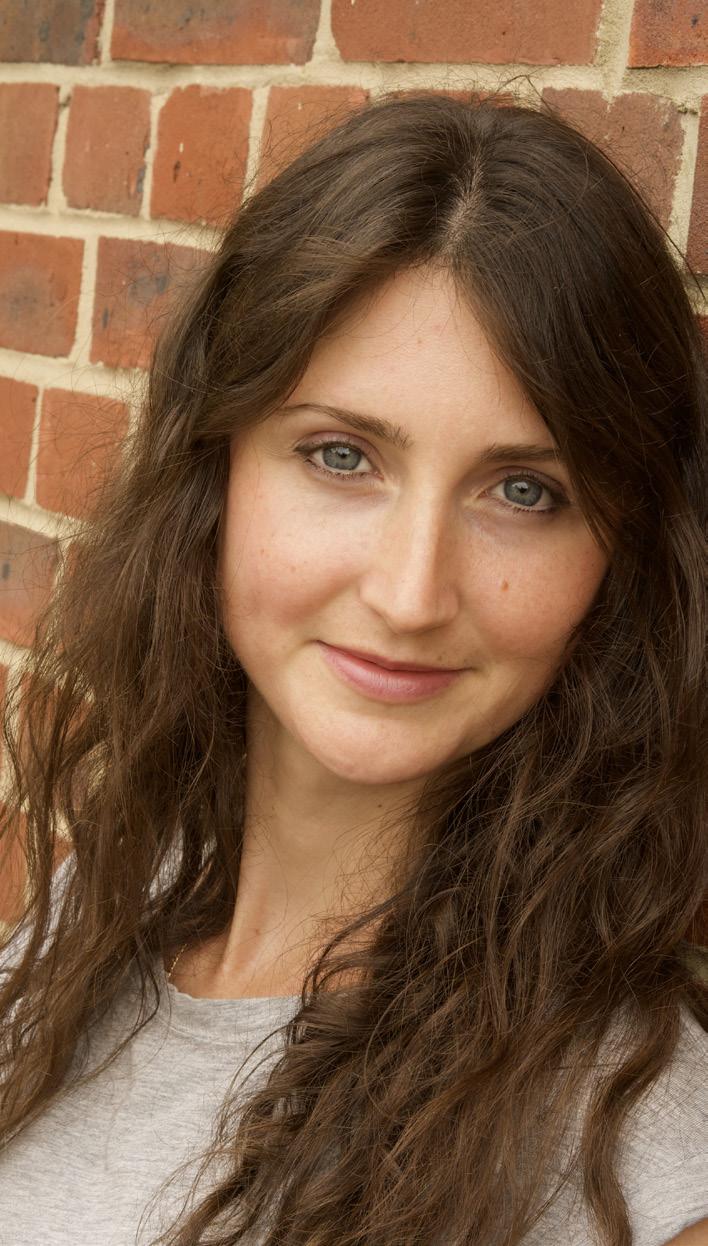
Why did you decide to become an osteopath?

I knew from a young age I wanted to help people and leaned towards a career in medicine. I saw an osteopath as a teenager for neck pain and headaches and became interested in the hands on, non-pharmacological approach to healthcare.
What exactly is osteopathy, and do you treat people of all ages?
Osteopathy is a form of manual therapy aimed at reducing pain and dysfunction within the body as a whole. An osteopath will listen to your full medical history, assess the way you stand and move and use a combination of a deep understanding of anatomy and physiology and a physical assessment to determine the cause of the pain or discomfort. It is suitable for all ages although not all osteopaths treat children. I now have rather frighteningly spent nearly 25 years in practice!
What are the benefits of osteopathy?
Osteopathy can be beneficial for all sorts of pain or tension in the body. We primarily work with back pain, neck pain and sports injuries. I see a full range of issues but did my post graduate training in Paediatrics (children). I have a special interest in supporting mothers who breastfeed and I have undertaken many hours of lactation studies.
What inspired you to become a massage therapist?
I love doing massage and seeing the positive effects that massage has on people. When I finished my first massage course, I didn’t expect to become a masseuse as my profession, but after many years of seeing how it benefited those whom I had given them to and the enjoyment I got from that, I felt it was something I needed to share.
What are the benefits of sports massage?
A full body deep sports massage is very important for our health. It provides an opportunity for both the body (and its muscles) as well as the mind to relax. It has significant benefits such as aiding recovery and performance for those training or carrying out sports activities.
Who have you worked for prior to working at Cowdray
Prior to working for Perfect Motion Physio at the Cowdray Therapy Rooms, I worked in the Ukraine where I was the sports masseuse for The Ukraine National Sports Orienteering team at the World Championships in the Czech Republic.
Beth Forrest - Osteopath
Rina Polishchuk - Sports Massage Therapist
Kim Lovelace - Shiatsu and Qigong Practitioner
What attracted you to learn to teach Shiatsu and Qigong?
After nearly 15 years in mainstream healthcare, I needed a change. A search began for healing disciplines that actively empowered my clients. This journey eventually led to Shiatsu. My Shiatsu training included modules of selfdevelopment, which is where Qigong first entered my life. Moving my body whilst cultivating mindful awareness ticked all my selfcare boxes.
What was your role in conventional healthcare?
I worked for over 15 years within hospital operating theatre and intensive care units specialising as a surgical and anaesthetic assistant. As well as developing a first-hand knowledge of human anatomy and pathology this work necessitated an awareness of patients’ needs, hopes and fears. Over time and with increasing frequency, I chose to work with relatively minor procedures when patients would be awake and able to express their feelings.
You have had a long-term affiliation with Cowdray Hall. What classes do you run?
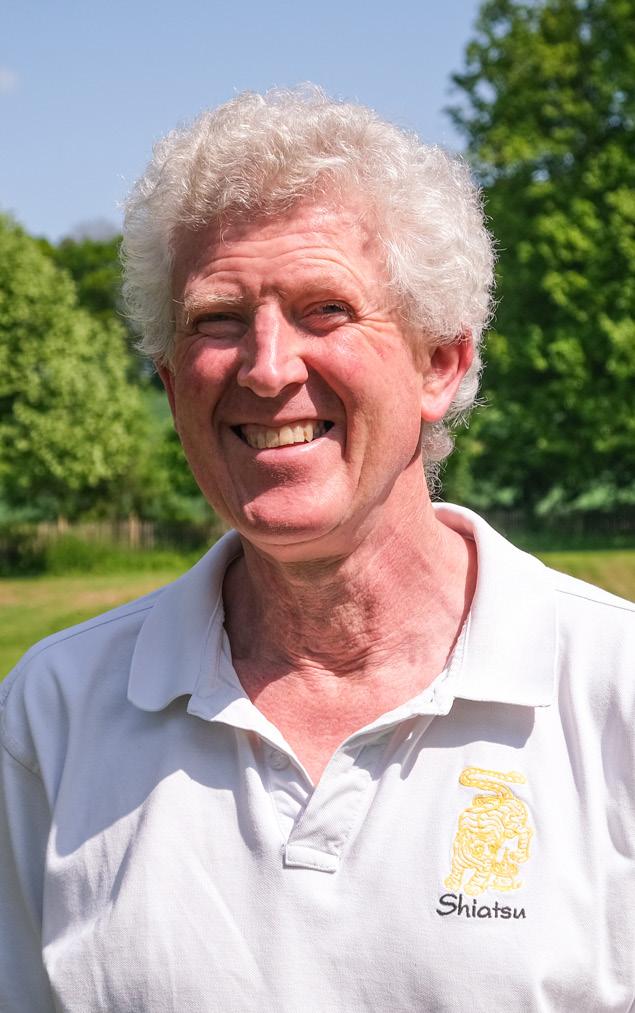
Each month, I run a three-hour Saturday morning Qigong class which provides simple practices that can be incorporated into daily life. I also team up with Sandrine Cranswick, a Mindfulness teacher. We run Mindful Day retreats incorporating formal meditation with Qigong.
Helen Logan - Psychotherapist
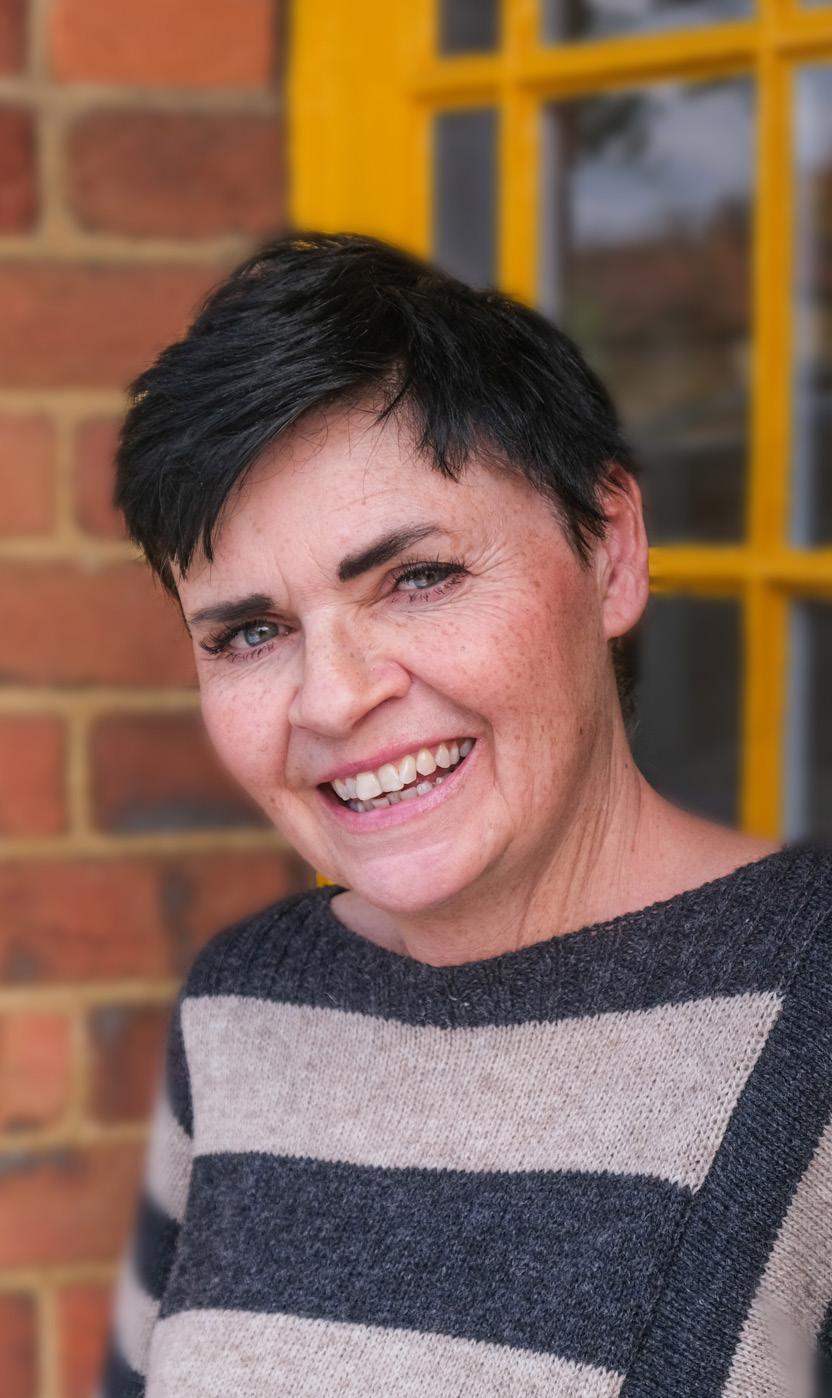
What made you decide to become a psychotherapist?
I initially trained in drama but as I embarked on an acting career, I discovered that the part I really enjoyed was not the being on the stage but rather the psychological exploration and understanding of the character. This, combined with voluntary work I started doing in my late teens for The Samaritans firmly pointed me in the direction of re-training in psychotherapy!
What exactly is psychotherapy and who might come to see a psychotherapist?
Psychotherapy is a collaborative process between the therapist and client, where through dialogue – either in person, or remotely (via the telephone or online)the client’s concerns, issues, behaviours and thoughts can be fully explored in a supportive, neutral and safe environment. I find that sometimes clients arrive new to therapy worried that their problem somehow doesn’t warrant psychotherapy but my response to that is that if it matters to the individual and if it is causing distress or consternation then they are absolutely in the right place.
What are the benefits of psychotherapy?
Psychotherapy can help build self-esteem and self-worth; it can help to reduce anxiety or depression; it can provide the individual with a better understanding of themselves. Clients can develop a toolset of emotional resources and coping mechanisms and an overall template for healthier and happier living.
For more information on Cowdray Hall and the Therapy Rooms, please visit: www.cowdray.co.uk/wellbeing To get in touch with any of our therapists, please visit: www.cowdray.co.uk/our-therapists
An easy to follow yet delicious summer recipe ideal to share with family and friends. All the ingredients are available from the Cowdray Farm Shop.
Sobrassada and Green Olive Risotto
by Ben Jupp Cowdray’s Executive Head Chef
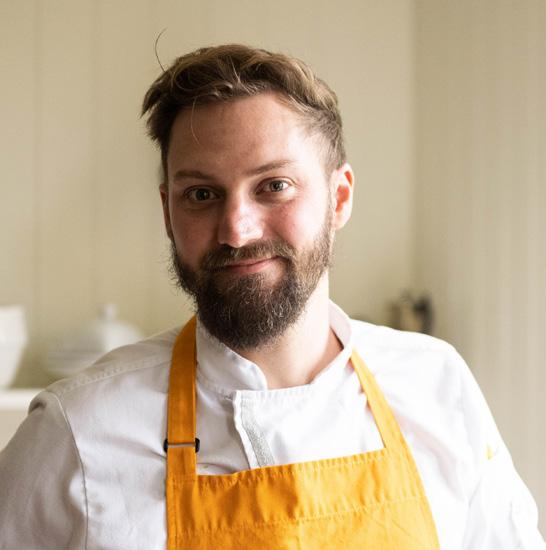
Serves 4
Prep: 15 mins
Cook: 30 mins
Ingredients:
5 banana shallots (finely diced)
3 cloves of garlic (minced)
175ml red wine
200g sobrassada (diced)
1 lemon (zest only)

20g basil (chopped)
180g risotto rice
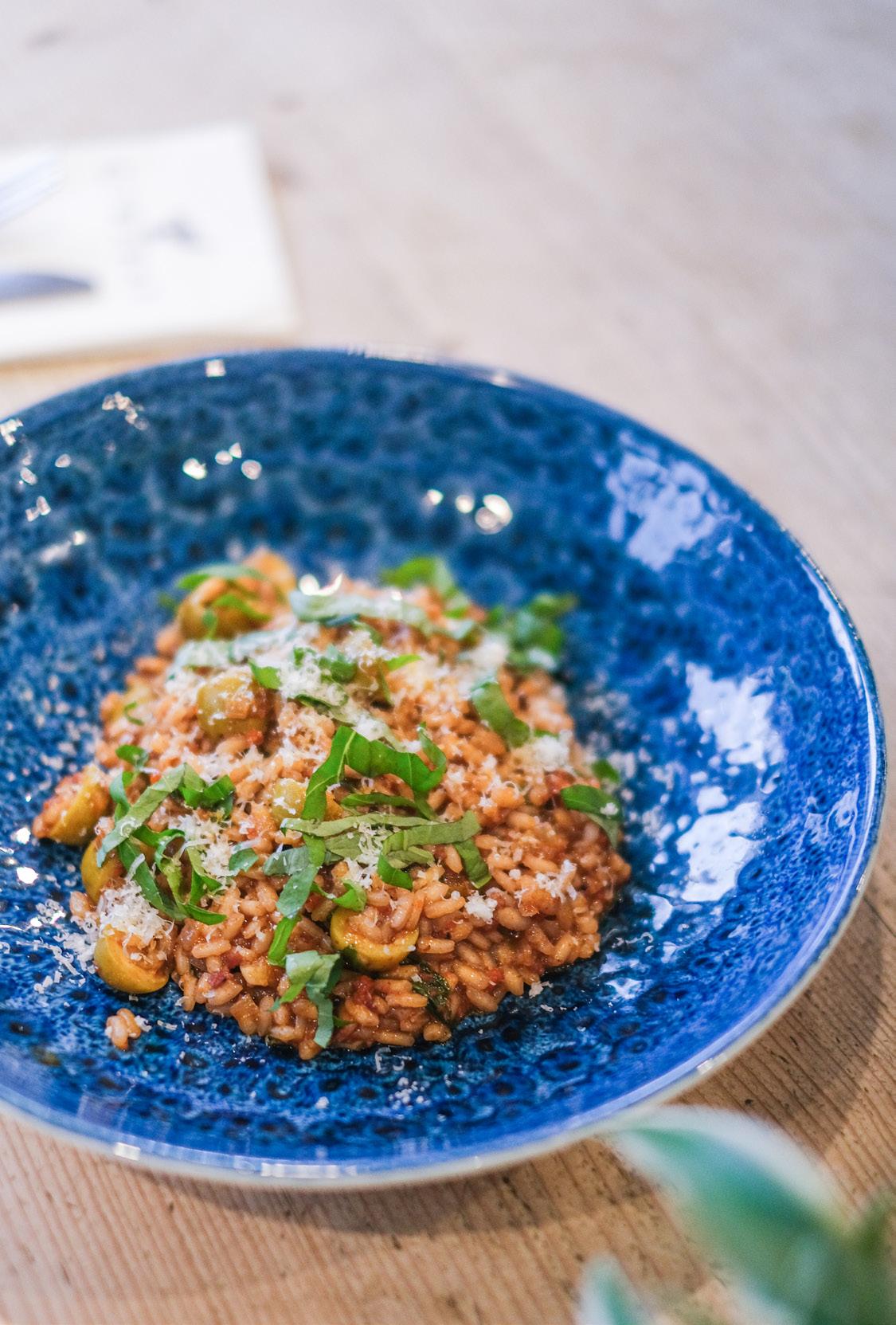
550ml hot chicken stock
100g green olives (halved) I used Perello olives.
30g grated parmesan
Method:


Place a heavy bottomed saucepan on a medium heat and drizzle with a little olive oil. Tip in the shallots and garlic and begin to sweat them down, stirring well for 5 minutes.
Add all the sobrassada and cook for a further 5 minutes, add the rice towards the end and fry for an extra minute.
Add the red wine and lemon zest and reduce until the wine has been absorbed.
Pour in the chicken stock, simmer for 15 minutes whilst stirring occasionally until the stock has been absorbed.
Skim half of the fat off the top of the risotto. Add two thirds of the parmesan, all the olives and half the basil and fold in gently.
Serve with the remaining parmesan and basil scattered over the top.
CONTACT www.cowdray.co.uk estateenquiries@cowdray.co.uk
812423 Cowdray Estate Office, Cowdray Park, Midhurst, West Sussex, QU29 0AQ @cowdrayestate @cowdrayestate @cowdrayestate
01730






 Clockwise from top: Costers Lodge from Cowdray’s holiday cottage portfolio, Cowdray’s 18-hole championship golf course, The Walled Garden Wedding Open Day, Cowdray’s Forager George Linklater, Dinner in Buck Hall at Cowdray House, The Cowdray Gundog Challenge
Clockwise from top: Costers Lodge from Cowdray’s holiday cottage portfolio, Cowdray’s 18-hole championship golf course, The Walled Garden Wedding Open Day, Cowdray’s Forager George Linklater, Dinner in Buck Hall at Cowdray House, The Cowdray Gundog Challenge














 www.markbeaumont.co.uk @markbeaumont_photographer
www.markbeaumont.co.uk @markbeaumont_photographer

 Adam Coxen, Founder of Tree House Retreats (left) and Jonathan Russell, Cowdray’s CEO (right)
Adam Coxen, Founder of Tree House Retreats (left) and Jonathan Russell, Cowdray’s CEO (right)
































